Paul van Yperen's Blog, page 335
August 31, 2016
Dominique Boschero
Among cult film fans, French actress Dominique Boschero (1934) is famous for her roles in dozens of Giallos and Spaghetti Westerns. The gorgeous brunette appeared in a surprisingly large amount of French and Italian films from the mid-1950s to the mid 1980s.
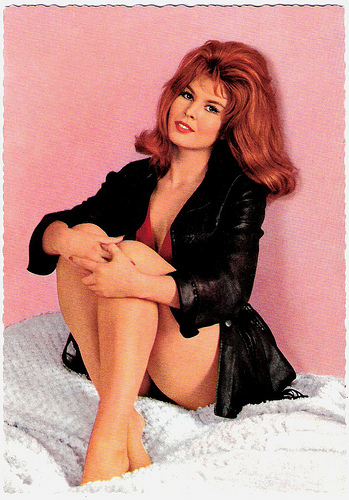
German postcard by Krüger, no. 902/357. Photo: Georg Michalke.
Showgirl
Dominique Boschero was born in Paris, France in 1934. She is the sister of actor-producer Martial Boschero. Their parents were Italian and when World War II broke out, the 5-year old Dominique was trusted in the hands of her grandparents in Frassino, a small Italian mountain village with a few hundred of inhabitants. There she grew up.
At 15, she returned to Paris and started to work as a janitor in a hospital and later she worked as a seamstress. With her tall length and her dark beauty, she found work as a model. Soon her beautiful face was on the covers of Paris’s premiere fashion magazines.
At the age of 18, she made her stage debut as a showgirl at the Paris music-hall La Nouvelle Eve (The New Eve). She also played small or uncredited roles in French films, such as Club de Femmes/Club of Women (Ralph Habib, 1956) with Nicole Courcel and Dany Carrel .
A year later, Boschero had a bigger part in Printemps a Paris/Springtime in Paris (Jean-Claude Roy, 1957) with Christine Carère and Philippe Nicaud. She got another bigger role in Delannoy's Le baron de l'ecluse/The Baron of the Locks (Jean Delannoy, 1960) starring Jean Gabin and Micheline Presle .
Following an interview with the Italian magazine Epoca, Dominique Boschero was noticed by an Italian producer, who invited her to come to the capital of the European cinema at the time, Rome.
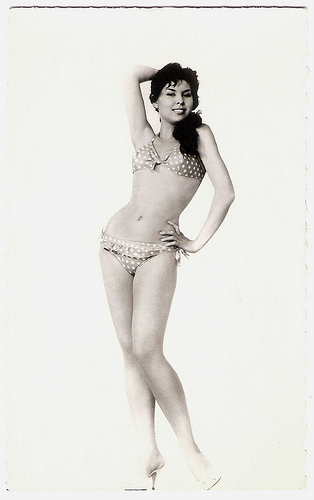
French postcard by Editions P.I., Paris, no. 892. Offered by les Carbones Korès 'Carboplane'. Photo: Sam Lévin.
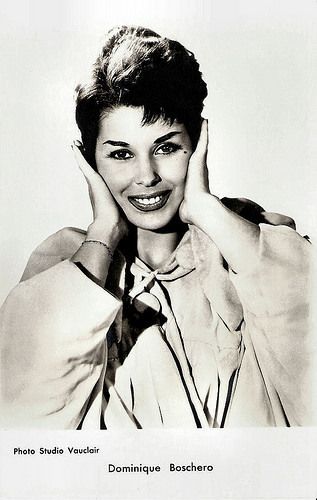
French postcard by Editions P.I., Paris, offered by Les Carbones Korès 'Carboplane', no. 1106. Photo: Studio Vauclair.
Queen of the Bird Men
Dominique Boschero headed off to Italy, beginning her Italian career with the Western comedy Un dollaro di fifa/A Dollar of Funk (Giorgio Simonelli, 1960), a spoof of Rio Bravo (Howard Hawks, 1959), which also starred Ugo Tognazzi and Walter Chiari .
She then appeared in a few Peplums (Sword and sandal films). Most notably was her winning performance as 'Queen of the Bird Men' in Ulisse contro Ercole/Ulysses Against Hercules (Mario Caiano, 1962) starring Georges Marchal .
Then she made a major impact as femme fatale in several Eurospy films. She appeared in early German/Italian examples of the genre such as Heißer Hafen Hong Kong/Hong Kong Hot Harbor (Jürgen Roland, 1962) with Marianne Koch , and Das geheimnis der chinesischen Nelke/The Secret of the Chinese Carnation (Rudolf Zehetgruber, 1964) starring Paul Dahlke . In the latter she appeared as a voluptuous vamp in a deadly plot of three different groups of plotting agents. They all chase after a microfilm with a secret formula for a new rocket fuel.
Then, she appeared opposite Giancarlo Giannini in his film debut, the interesting thriller Libido (Ernesto Gastaldi, Vittorio Salerno, 1965). Boschero played another leading role in Furia in Marakech/Fury at Marrakesh (Mino Loy, Luciano Martino, 1966).
According to Tom Lisanti and Louis Paul, authors of the study Film Fatales, Boschero's ‘ultimate screen appearance’, was “her screen-stealing turn in the bizarre uninhibited wacky, wild and completely unbelievable secret agent-super hero hybrid” Come Rubare la Corona d’Inghilterra/Argoman the Fantastic Superman (Sergio Grieco, 1967). Boschero at first appears as a seemingly lost and helpless woman who seduces Argoman (Roger Browne) and then turns out to be a mastermind villain. At the climax of the film, she sadistically tortures Argoman and tries to remove his magic powers permanently. At IMDb, reviewer Gulaq-2 writes: “A CAMP classic of maximum proportions, which ruled the world in the late sixties, conquering all the known B-movies markets”.
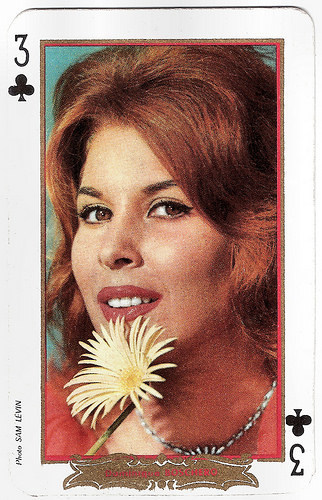
French playing card. Photo: Sam Lévin.
Guilty Pleasure
In the 1970s, Dominique Boschero continued popping up in such Giallos as Chi l'ha vista morire?/Who Saw Her Die (Aldo Lado, 1972) starring former James Bond George Lazenby, and Tutti i colori del buio/All the Colors of the Dark (Sergio Martino, 1972) with George Hilton and Edwige Fenech.
She also appeared in the Spaghetti Western Los buitres cavarán tu fosa/And the Crows Will Dig Your Grave (Juan Bosch, 1972), the Italian-Belgian sex comedy Je suis une call-girl/I am a call-girl (Jack Guy, 1973), and the horror film Il prato macchiato di rosso/The Bloodstained Lawn (Riccardo Ghione, 1973) with Nino Castelnuovo.
IMDb reviewer Babycarrot67 calls this horror film a 'guilty pleasure': “An obvious commentary on the rich and powerful exploiting the more unfortunate members of society, this film does not take itself very seriously, and most of the cast, especially Marina Malfatti as one of the aristocrats, appears to be having a good time. The film's claustrophobic atmosphere gives it just enough feeling of unease to make it a credible horror film, and the film's overall weirdness and eccentricity help it cross over the finish line of viewer satisfaction. This film could be the definition of a motion picture 'guilty pleasure' although one should not feel guilty during the viewing”.
Boschero had a romance with Claudio Camaso (Claudio Volonté), the brother of actor Gianmaria Volonté. Camaso was involved with an alleged bomb in the Vatican. This scandal and her cursed relationship with the actor who eventually committed suicide in jail in 1977, slowed down her career. In 1974 Boschero retired from the cinema and withdrew to Frassino. She later would have a relation with the singer Franco Califano.
In 1986 she returned on television in the soap series Passioni/Passions (Riccardo Donna, 1986). Dominique Boschero lives in Frassino, North-West Italy, where she is involved in the investigation and preservation of the occitan language. From the end of the 1960s she is interested in this subject after meeting François Fontan, founder of the Parti nationaliste occitan, and the poet Antonio Bodrero (Barba Toni Baudrier).
Trailer Libido (1965). Source: neverlando74 (YouTube).
Trailer Come Rubare la Corona d’Inghilterra/Argoman the Fantastic Superman (1967). Source: Jordotech (YouTube).
Italian trailer for the Spaghetti Western Un Treno per Durango/A Train To Durango (1968). Source: Neverlando74 (YouTube).
International trailer for Chi l'ha vista morire?/Who Saw Her Die (1972). Source: Italo-Cinema Trailer (YouTube).
Sources: Tom Lisanti and Louis Paul (Film Fatales: women in espionage films and television, 1962-1973), European Film Review, Wikipedia (French and Italian), and .

German postcard by Krüger, no. 902/357. Photo: Georg Michalke.
Showgirl
Dominique Boschero was born in Paris, France in 1934. She is the sister of actor-producer Martial Boschero. Their parents were Italian and when World War II broke out, the 5-year old Dominique was trusted in the hands of her grandparents in Frassino, a small Italian mountain village with a few hundred of inhabitants. There she grew up.
At 15, she returned to Paris and started to work as a janitor in a hospital and later she worked as a seamstress. With her tall length and her dark beauty, she found work as a model. Soon her beautiful face was on the covers of Paris’s premiere fashion magazines.
At the age of 18, she made her stage debut as a showgirl at the Paris music-hall La Nouvelle Eve (The New Eve). She also played small or uncredited roles in French films, such as Club de Femmes/Club of Women (Ralph Habib, 1956) with Nicole Courcel and Dany Carrel .
A year later, Boschero had a bigger part in Printemps a Paris/Springtime in Paris (Jean-Claude Roy, 1957) with Christine Carère and Philippe Nicaud. She got another bigger role in Delannoy's Le baron de l'ecluse/The Baron of the Locks (Jean Delannoy, 1960) starring Jean Gabin and Micheline Presle .
Following an interview with the Italian magazine Epoca, Dominique Boschero was noticed by an Italian producer, who invited her to come to the capital of the European cinema at the time, Rome.

French postcard by Editions P.I., Paris, no. 892. Offered by les Carbones Korès 'Carboplane'. Photo: Sam Lévin.

French postcard by Editions P.I., Paris, offered by Les Carbones Korès 'Carboplane', no. 1106. Photo: Studio Vauclair.
Queen of the Bird Men
Dominique Boschero headed off to Italy, beginning her Italian career with the Western comedy Un dollaro di fifa/A Dollar of Funk (Giorgio Simonelli, 1960), a spoof of Rio Bravo (Howard Hawks, 1959), which also starred Ugo Tognazzi and Walter Chiari .
She then appeared in a few Peplums (Sword and sandal films). Most notably was her winning performance as 'Queen of the Bird Men' in Ulisse contro Ercole/Ulysses Against Hercules (Mario Caiano, 1962) starring Georges Marchal .
Then she made a major impact as femme fatale in several Eurospy films. She appeared in early German/Italian examples of the genre such as Heißer Hafen Hong Kong/Hong Kong Hot Harbor (Jürgen Roland, 1962) with Marianne Koch , and Das geheimnis der chinesischen Nelke/The Secret of the Chinese Carnation (Rudolf Zehetgruber, 1964) starring Paul Dahlke . In the latter she appeared as a voluptuous vamp in a deadly plot of three different groups of plotting agents. They all chase after a microfilm with a secret formula for a new rocket fuel.
Then, she appeared opposite Giancarlo Giannini in his film debut, the interesting thriller Libido (Ernesto Gastaldi, Vittorio Salerno, 1965). Boschero played another leading role in Furia in Marakech/Fury at Marrakesh (Mino Loy, Luciano Martino, 1966).
According to Tom Lisanti and Louis Paul, authors of the study Film Fatales, Boschero's ‘ultimate screen appearance’, was “her screen-stealing turn in the bizarre uninhibited wacky, wild and completely unbelievable secret agent-super hero hybrid” Come Rubare la Corona d’Inghilterra/Argoman the Fantastic Superman (Sergio Grieco, 1967). Boschero at first appears as a seemingly lost and helpless woman who seduces Argoman (Roger Browne) and then turns out to be a mastermind villain. At the climax of the film, she sadistically tortures Argoman and tries to remove his magic powers permanently. At IMDb, reviewer Gulaq-2 writes: “A CAMP classic of maximum proportions, which ruled the world in the late sixties, conquering all the known B-movies markets”.

French playing card. Photo: Sam Lévin.
Guilty Pleasure
In the 1970s, Dominique Boschero continued popping up in such Giallos as Chi l'ha vista morire?/Who Saw Her Die (Aldo Lado, 1972) starring former James Bond George Lazenby, and Tutti i colori del buio/All the Colors of the Dark (Sergio Martino, 1972) with George Hilton and Edwige Fenech.
She also appeared in the Spaghetti Western Los buitres cavarán tu fosa/And the Crows Will Dig Your Grave (Juan Bosch, 1972), the Italian-Belgian sex comedy Je suis une call-girl/I am a call-girl (Jack Guy, 1973), and the horror film Il prato macchiato di rosso/The Bloodstained Lawn (Riccardo Ghione, 1973) with Nino Castelnuovo.
IMDb reviewer Babycarrot67 calls this horror film a 'guilty pleasure': “An obvious commentary on the rich and powerful exploiting the more unfortunate members of society, this film does not take itself very seriously, and most of the cast, especially Marina Malfatti as one of the aristocrats, appears to be having a good time. The film's claustrophobic atmosphere gives it just enough feeling of unease to make it a credible horror film, and the film's overall weirdness and eccentricity help it cross over the finish line of viewer satisfaction. This film could be the definition of a motion picture 'guilty pleasure' although one should not feel guilty during the viewing”.
Boschero had a romance with Claudio Camaso (Claudio Volonté), the brother of actor Gianmaria Volonté. Camaso was involved with an alleged bomb in the Vatican. This scandal and her cursed relationship with the actor who eventually committed suicide in jail in 1977, slowed down her career. In 1974 Boschero retired from the cinema and withdrew to Frassino. She later would have a relation with the singer Franco Califano.
In 1986 she returned on television in the soap series Passioni/Passions (Riccardo Donna, 1986). Dominique Boschero lives in Frassino, North-West Italy, where she is involved in the investigation and preservation of the occitan language. From the end of the 1960s she is interested in this subject after meeting François Fontan, founder of the Parti nationaliste occitan, and the poet Antonio Bodrero (Barba Toni Baudrier).
Trailer Libido (1965). Source: neverlando74 (YouTube).
Trailer Come Rubare la Corona d’Inghilterra/Argoman the Fantastic Superman (1967). Source: Jordotech (YouTube).
Italian trailer for the Spaghetti Western Un Treno per Durango/A Train To Durango (1968). Source: Neverlando74 (YouTube).
International trailer for Chi l'ha vista morire?/Who Saw Her Die (1972). Source: Italo-Cinema Trailer (YouTube).
Sources: Tom Lisanti and Louis Paul (Film Fatales: women in espionage films and television, 1962-1973), European Film Review, Wikipedia (French and Italian), and .
Published on August 31, 2016 22:00
August 30, 2016
Ingmarssönerna (1919)
My partner Ivo Blom recently visited Sweden and found in a Stockholm shop this complete series of postcards of Ingmarssönerna (1919), also known as Dawn of Love and Sons of Ingmar. This film was directed by one of the two great masters of the Scandinavian silent cinema, Victor Sjöström. The maestro also plays one of the leading roles.
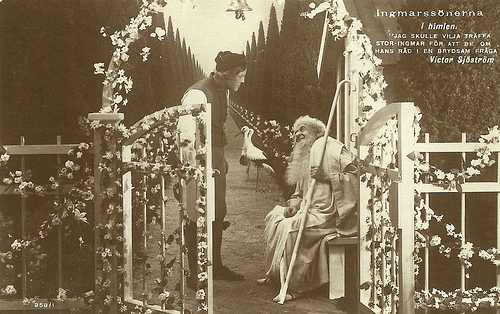
Swedish postcard by Nordisk Konst, Stockholm, no. 958/1. Photo: publicity still for Ingmarssönerna (Victor Sjöström, 1919) with Victor Sjöström as Young Ingmar Ingmarsson at Heaven's Gate. The caption translates: I would like to meet Old Ingmar to ask for his advice in an awkward matter.

Swedish postcard by Nordisk Konst, Stockholm, no. 958/2. Photo: publicity still for Ingmarssönerna (Victor Sjöström, 1919), with Harriet Bosse. Translation caption: Brita from Bergskog (Mountain forest).
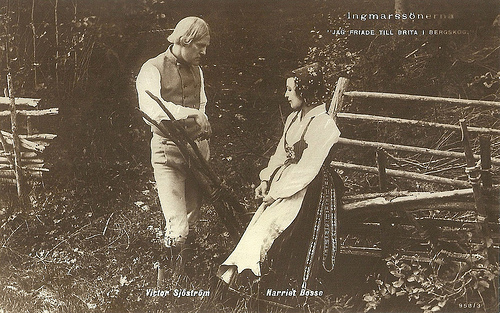
Swedish postcard by Nordisk Konst, Stockholm, no. 958/3. Photo: publicity still for Ingmarssönerna (Victor Sjöström, 1919), with Victor Sjöström and Harriet Bosse. Translation caption: I proposed to Brita from Bergskog.
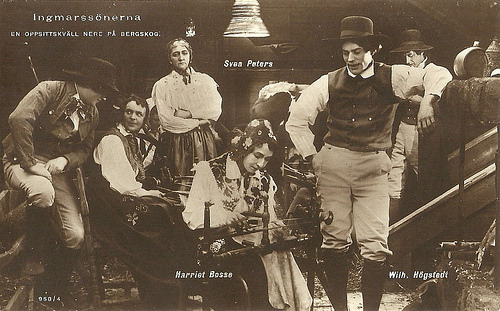
Swedish postcard by Nordisk Konst, Stockholm, no. 958/4. Photo: publicity still for Ingmarssönerna (Victor Sjöström, 1919), with Svea Peters (as Brita's mother), Harriet Bosse and Wilhelm Högstedt (as Sven). Translation caption: An nightly contest down at Bergskog.
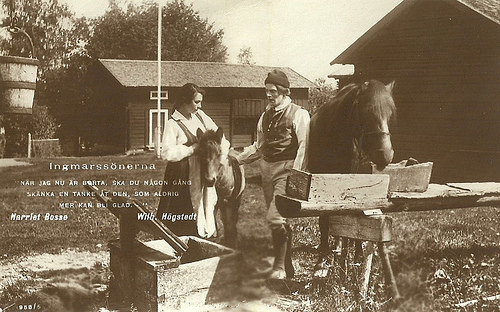
Swedish postcard by Nordisk Konst, Stockholm, no. 958/5. Photo: publicity still for Ingmarssönerna (Victor Sjöström, 1919), with Harriet Bosse and Wilhelm Högstedt. Translation caption: When I will be gone, will you give a thought to him who cannot be pleased?
Born out of wedlock
In Ingmarssönerna/Dawn of Love (1919), stage actress Harriet Bosse, the third wife of author August Strindberg, plays the leading role of the young farmer girl Brita.
Brita kills her baby girl, born out of wedlock. The father, young Ingmar Ingmarsson ( Victor Sjöström ), is the son of a rich and proud farmer's family, and he refuses to recognise his daughter.
This makes Brita an outcast, and she tries to commit suicide, but she is held back from jumping off the cliffs.
While Brita is in prison, Ingmar visits old Ingmar (Tore Svennberg) in heaven and he hears that he should forgive. Young Imgmar recognises his part in Brita's behaviour. When Brita is released, Ingmar asks for her hand. They marry and start a new life.
Ingmarssönerna/Sons of Ingmar (1919) is based on the first chapters of Selma Lagerlöf's novel Jerusalem (1901-1902), about religious emigrants from Sweden to Palestine. Lagerlöf would win the Nobel Prize for Literature for Jerusalem. In 1920, Victor Sjöström would also film Karin Ingmarsdotter, based on other chapters from the same novel.
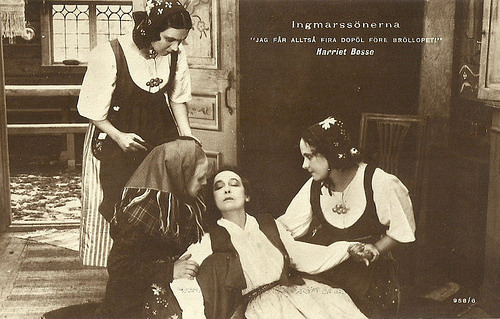
Swedish postcard by Nordisk Konst, Stockholm, no. 958/6. Photo: publicity still for Ingmarssönerna (Victor Sjöström, 1919), with Harriet Bosse. Translation caption: I will thus have to celebrate the baptism before the wedding.
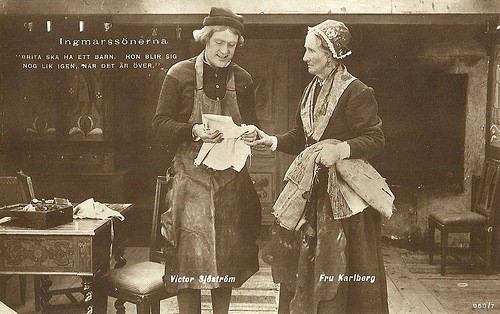
Swedish postcard by Nordisk Konst, Stockholm, no. 958/7. Photo: publicity still for Ingmarssönerna (Victor Sjöström, 1919), with Victor Sjöström and Hildur Karlberg (as jis mother Marta). Translation caption: Mother: It is because Brita will have her child, but then she will recover and it will be over.

Swedish postcard by Nordisk Konst, Stockholm, no. 958/8. Photo: publicity still for Ingmarssönerna (Victor Sjöström, 1919), with Harriet Bosse. Translation caption: I have to do something or I won't find any rest in my soul.
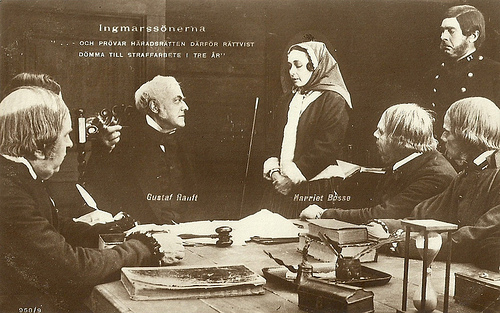
Swedish postcard by Nordisk Konst, Stockholm, no. 958/9. Photo: publicity still for Ingmarssönerna (Victor Sjöström, 1919), with Gustaf Ranft (as the Judge) and Harriet Bosse. Translation caption: And so before the district court the judge thinks it fair to sentence her to three years of prison.

Swedish postcard by Nordisk Konst, Stockholm, no. 958/10. Photo: publicity still for Ingmarssönerna (Victor Sjöström, 1919), with Harriet Bosse. Translation caption: And now the prison chaplain urges her to write to Ingmar.
Victor Seastrom
Victor Sjöström (1879-1960) was one of the most important Swedish actors and directors. He was famous for his poetic and touching narratives.
Among his classic Swedish films are Ingeborg Holm (1913), Terje Vigen/A Man There Was (1916) - by then the most expensive Swedish film made - and Körkarlen/he Phantom Carriage (1920), which is considered one of the best Swedish silent films.
From 1923 on, Sjöström worked in the USA under the name of Victor Seastrom. In Hollywood, he directed such films as He Who Gets Slapped (1924), starring Lon Chaney , and The Wind (1928), starring Lilian Gish.
Sjöström returned to Sweden at the advent of sound cinema, and he continued working in Scandinavia. Memorable is his last acting part as the old professor in Smultronstället/Wild Strawberries (1957) by Ingmar Bergman.
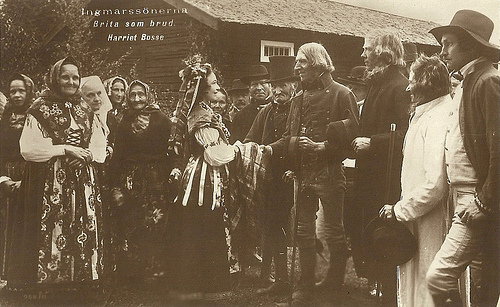
Swedish postcard by Nordisk Konst, Stockholm, no. 958/11. Photo: publicity still for Ingmarssönerna (Victor Sjöström, 1919), with Harriet Bosse. Translation caption: Brita the bride.
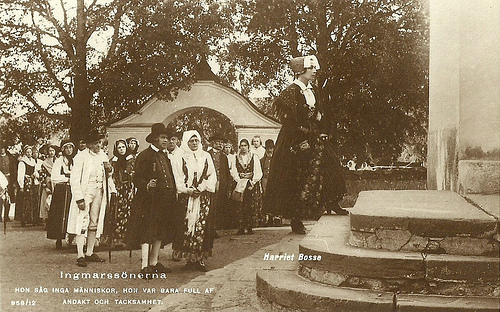
Swedish postcard by Nordisk Konst, Stockholm, no. 958/12. Photo: publicity still for Ingmarssönerna (Victor Sjöström, 1919), with Harriet Bosse. Translation caption: She saw no one, she was just full of devotion and gratitude.

Swedish postcard by Nordisk Konst, Stockholm, no. 958/13. Photo: publicity still for Ingmarssönerna (Victor Sjöström, 1919), with Victor Sjöström and Harriet Bosse. Translation caption: Now they understood why they were sitting alone on the bench.
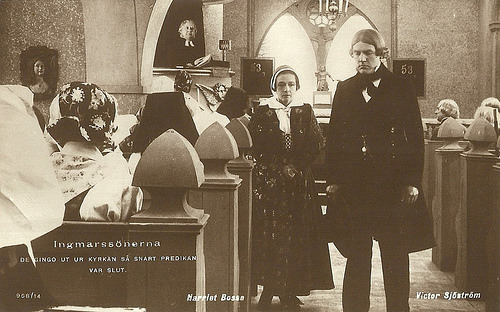
Swedish postcard by Nordisk Konst, Stockholm, no. 958/14. Photo: publicity still for Ingmarssönerna (Victor Sjöström, 1919), with Victor Sjöström and Harriet Bosse. Translation caption: They walked out of the church as soon as the sermon was over.
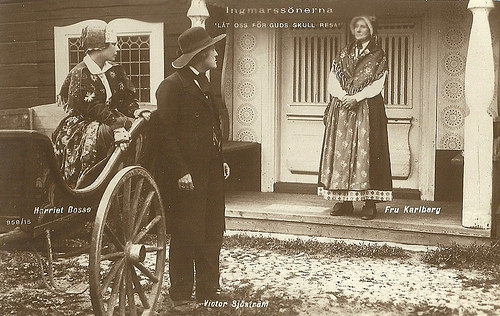
Swedish postcard by Nordisk Konst, Stockholm, no. 958/15. Photo: publicity still for Ingmarssönerna (Victor Sjöström, 1919), with Harriet Bosse, Victor Sjöström and Hildur Karlberg. Translation caption: For God's sake, let us travel.
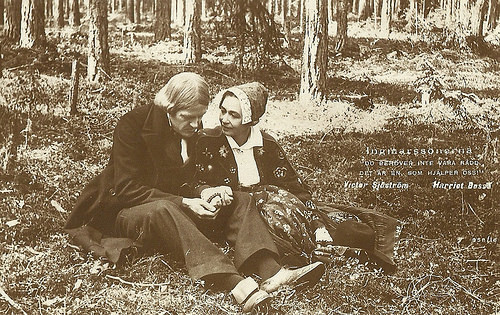
Swedish postcard by Nordisk Konst, Stockholm, no. 958/16. Photo: publicity still for Ingmarssönerna (Victor Sjöström, 1919), with Victor Sjöström and Harriet Bosse. Translation caption: You don't need to be afraid, there is one who helps us.
Sources: Wikipedia and IMDb.
This is a post for Postcard Friendship Friday, hosted by Beth at the The Best Hearts are Crunchy. You can visit her by clicking on the button below.


Swedish postcard by Nordisk Konst, Stockholm, no. 958/1. Photo: publicity still for Ingmarssönerna (Victor Sjöström, 1919) with Victor Sjöström as Young Ingmar Ingmarsson at Heaven's Gate. The caption translates: I would like to meet Old Ingmar to ask for his advice in an awkward matter.

Swedish postcard by Nordisk Konst, Stockholm, no. 958/2. Photo: publicity still for Ingmarssönerna (Victor Sjöström, 1919), with Harriet Bosse. Translation caption: Brita from Bergskog (Mountain forest).

Swedish postcard by Nordisk Konst, Stockholm, no. 958/3. Photo: publicity still for Ingmarssönerna (Victor Sjöström, 1919), with Victor Sjöström and Harriet Bosse. Translation caption: I proposed to Brita from Bergskog.

Swedish postcard by Nordisk Konst, Stockholm, no. 958/4. Photo: publicity still for Ingmarssönerna (Victor Sjöström, 1919), with Svea Peters (as Brita's mother), Harriet Bosse and Wilhelm Högstedt (as Sven). Translation caption: An nightly contest down at Bergskog.

Swedish postcard by Nordisk Konst, Stockholm, no. 958/5. Photo: publicity still for Ingmarssönerna (Victor Sjöström, 1919), with Harriet Bosse and Wilhelm Högstedt. Translation caption: When I will be gone, will you give a thought to him who cannot be pleased?
Born out of wedlock
In Ingmarssönerna/Dawn of Love (1919), stage actress Harriet Bosse, the third wife of author August Strindberg, plays the leading role of the young farmer girl Brita.
Brita kills her baby girl, born out of wedlock. The father, young Ingmar Ingmarsson ( Victor Sjöström ), is the son of a rich and proud farmer's family, and he refuses to recognise his daughter.
This makes Brita an outcast, and she tries to commit suicide, but she is held back from jumping off the cliffs.
While Brita is in prison, Ingmar visits old Ingmar (Tore Svennberg) in heaven and he hears that he should forgive. Young Imgmar recognises his part in Brita's behaviour. When Brita is released, Ingmar asks for her hand. They marry and start a new life.
Ingmarssönerna/Sons of Ingmar (1919) is based on the first chapters of Selma Lagerlöf's novel Jerusalem (1901-1902), about religious emigrants from Sweden to Palestine. Lagerlöf would win the Nobel Prize for Literature for Jerusalem. In 1920, Victor Sjöström would also film Karin Ingmarsdotter, based on other chapters from the same novel.

Swedish postcard by Nordisk Konst, Stockholm, no. 958/6. Photo: publicity still for Ingmarssönerna (Victor Sjöström, 1919), with Harriet Bosse. Translation caption: I will thus have to celebrate the baptism before the wedding.

Swedish postcard by Nordisk Konst, Stockholm, no. 958/7. Photo: publicity still for Ingmarssönerna (Victor Sjöström, 1919), with Victor Sjöström and Hildur Karlberg (as jis mother Marta). Translation caption: Mother: It is because Brita will have her child, but then she will recover and it will be over.

Swedish postcard by Nordisk Konst, Stockholm, no. 958/8. Photo: publicity still for Ingmarssönerna (Victor Sjöström, 1919), with Harriet Bosse. Translation caption: I have to do something or I won't find any rest in my soul.

Swedish postcard by Nordisk Konst, Stockholm, no. 958/9. Photo: publicity still for Ingmarssönerna (Victor Sjöström, 1919), with Gustaf Ranft (as the Judge) and Harriet Bosse. Translation caption: And so before the district court the judge thinks it fair to sentence her to three years of prison.

Swedish postcard by Nordisk Konst, Stockholm, no. 958/10. Photo: publicity still for Ingmarssönerna (Victor Sjöström, 1919), with Harriet Bosse. Translation caption: And now the prison chaplain urges her to write to Ingmar.
Victor Seastrom
Victor Sjöström (1879-1960) was one of the most important Swedish actors and directors. He was famous for his poetic and touching narratives.
Among his classic Swedish films are Ingeborg Holm (1913), Terje Vigen/A Man There Was (1916) - by then the most expensive Swedish film made - and Körkarlen/he Phantom Carriage (1920), which is considered one of the best Swedish silent films.
From 1923 on, Sjöström worked in the USA under the name of Victor Seastrom. In Hollywood, he directed such films as He Who Gets Slapped (1924), starring Lon Chaney , and The Wind (1928), starring Lilian Gish.
Sjöström returned to Sweden at the advent of sound cinema, and he continued working in Scandinavia. Memorable is his last acting part as the old professor in Smultronstället/Wild Strawberries (1957) by Ingmar Bergman.

Swedish postcard by Nordisk Konst, Stockholm, no. 958/11. Photo: publicity still for Ingmarssönerna (Victor Sjöström, 1919), with Harriet Bosse. Translation caption: Brita the bride.

Swedish postcard by Nordisk Konst, Stockholm, no. 958/12. Photo: publicity still for Ingmarssönerna (Victor Sjöström, 1919), with Harriet Bosse. Translation caption: She saw no one, she was just full of devotion and gratitude.

Swedish postcard by Nordisk Konst, Stockholm, no. 958/13. Photo: publicity still for Ingmarssönerna (Victor Sjöström, 1919), with Victor Sjöström and Harriet Bosse. Translation caption: Now they understood why they were sitting alone on the bench.

Swedish postcard by Nordisk Konst, Stockholm, no. 958/14. Photo: publicity still for Ingmarssönerna (Victor Sjöström, 1919), with Victor Sjöström and Harriet Bosse. Translation caption: They walked out of the church as soon as the sermon was over.

Swedish postcard by Nordisk Konst, Stockholm, no. 958/15. Photo: publicity still for Ingmarssönerna (Victor Sjöström, 1919), with Harriet Bosse, Victor Sjöström and Hildur Karlberg. Translation caption: For God's sake, let us travel.

Swedish postcard by Nordisk Konst, Stockholm, no. 958/16. Photo: publicity still for Ingmarssönerna (Victor Sjöström, 1919), with Victor Sjöström and Harriet Bosse. Translation caption: You don't need to be afraid, there is one who helps us.
Sources: Wikipedia and IMDb.
This is a post for Postcard Friendship Friday, hosted by Beth at the The Best Hearts are Crunchy. You can visit her by clicking on the button below.

Published on August 30, 2016 22:00
August 29, 2016
Nita Raya
Beautiful Nita Raya (1915-2015) was a French dancer, singer and actress. She was a lead dancer at the Folies-Bergère. For ten years, she was the companion of Maurice Chevalier.

French postcard by EPC, no. 36. Photo: Studio Harcourt.
La Mexicana
Nita Raya was born Raïssa Beloff-Yerkovitch in 1915 in Chişinău, Moldovia – then known as Kishinev and part of the Russian Empire. She came from a Jewish Romanian family. Her father was Vladimir Beloff, who worked as a tailor and a taxi driver, and her mother was Angelina or Anna Jerkovitch.
In 1926 mother and daughter moved to France, where Nita attended dance courses by the celebrated Russian artist Olga Préobrajenska. She made her dance debut in the Parisian cabaret Le bal Tabarin, where she danced the Cancan at the side of Viviane Romance. An accident finished her dance career and she then attended acting courses by René Simon.
She made her first film appearance in the short comedy Olive se marie/Olive Marries (Maurice de Canonge, 1931). Three years later this debut was followed by the feature comedies Le Père Lampion/Father Lampion (Christian-Jaque, 1934) with Félicien Tramel , and L'École des contribuables/The School for Taxpayers (René Guissart, 1934) with Armand Bernard .
On stage she was part of the first production of Marie Galante (1934) a musical written by Jacques Deval and Roger Fernay with music by Kurt Weill. The following year she had a small part in the historical film Lucrèce Borgia/Lucrezia Borgia (Abel Gance, 1935), starring Edwige Feuillère . She also had supporting parts in Sous la griffe/Under the claw (Christian-Jaque, 1935) with Constant Rémy, and Sacré Léonce/Holy Leonce (Christian-Jaque, 1936).
The 19-years old Raya fell in love with the 46-years old Maurice Chevalier, who had just returned to Paris from his Hollywood adventure. Between 1935 and 1945, she was his companion. The following years she got bigger film parts. She had the female lead opposite singer Tino Rossi in Au son des guitars/The Sound of Guitars (Pierre-Jean Ducis, 1936).
She also had bigger parts in the comedies Les Rois du sport/The Kings of Sport (Pierre Colombier, 1937) with Fernandel, Raimu and Jules Berry , and Ignace (Pierre Colombier, 1937), again with Fernandel . In the latter she sang the hit La Mexicana. The following year, she starred opposite Victor Boucher in the romantic comedy Chipée (Roger Goupillières, 1938). She also performed in Music Halls like Petit-Casino, Bobino, l’Européen, and l’ABC.

French postcard, no. 585. Photo: Teddy Piaz.
Lead Dancer at the Follies-Bergère
In 1939, Nita Raya appeared in the drama Entente cordiale/Cordial agreement (Marcel L'Herbier, 1939), starring Gaby Morlay , Victor Francen and Pierre Richard-Willm , and based on a book by André Maurois. The film depicts the 1904 signing of the Entente Cordiale creating an alliance between Britain and France and ending their historic rivalry. It was made with an eye to its propaganda value, as the Second World War had broken out and Britain and France were allies fighting against Nazi Germany.
After Bécassine (Pierre Caron, 1940) with Paulette Dubost, Raya would not be seen in the cinemas for more than 10 years. D.B. DuMonteil at IMDb: "Bécassine was one of the first European comic strips, although its author did not use the speech bubbles; it began to define what is known under the ‘clear line’ term, which spawned the whole Belgian school, of which Tintin is the most famous work. But the people are very divided on the character: a lot of people (particularly Bretons) have always thought that this bubble head servant was a way of laughing at Bretagne, which would have been behind the times. (…) When Becassine was transferred to the screen in 1940, there was an outcry in Bretagne: a real storm in a teacup, considering what was happening in France at the time.”
During the war, the Jewish Raya and her companion Maurice Chevalier were hosted by Desha Delteil. Chevalier helped Raya to get false identity papers so she could escape deportation.
After the war she appeared in operettas by the company of Francis Lopez. She returned briefly in the cinemas in the anthology film La rafle est pour ce soir/The raid is tonight (Maurice Dekobra, 1954) based on stories by Guy de Maupassant. It was her final film.
She worked as the lead dancer in the revue at the famous Follies-Bergère. During the 1960s she often performed with Édith Piaf and wrote two songs for her, Je m’imagine and Toujours aimer. Nita Raya died in 2015 in a retirement home in Trégastel in Brittany. She was 99. For a time she was married to Joseph Akcelrod. She was survived by her son Patrick Akcelrod and his family.

French postcard by Erpé, no. 182. Photo: Studio Harcourt.
Sources: D.B. DuMonteil (IMDb), Ariane Trifin (Nita Raya Blog - French), Le Télégramme (French), Wikipedia (French), and .

French postcard by EPC, no. 36. Photo: Studio Harcourt.
La Mexicana
Nita Raya was born Raïssa Beloff-Yerkovitch in 1915 in Chişinău, Moldovia – then known as Kishinev and part of the Russian Empire. She came from a Jewish Romanian family. Her father was Vladimir Beloff, who worked as a tailor and a taxi driver, and her mother was Angelina or Anna Jerkovitch.
In 1926 mother and daughter moved to France, where Nita attended dance courses by the celebrated Russian artist Olga Préobrajenska. She made her dance debut in the Parisian cabaret Le bal Tabarin, where she danced the Cancan at the side of Viviane Romance. An accident finished her dance career and she then attended acting courses by René Simon.
She made her first film appearance in the short comedy Olive se marie/Olive Marries (Maurice de Canonge, 1931). Three years later this debut was followed by the feature comedies Le Père Lampion/Father Lampion (Christian-Jaque, 1934) with Félicien Tramel , and L'École des contribuables/The School for Taxpayers (René Guissart, 1934) with Armand Bernard .
On stage she was part of the first production of Marie Galante (1934) a musical written by Jacques Deval and Roger Fernay with music by Kurt Weill. The following year she had a small part in the historical film Lucrèce Borgia/Lucrezia Borgia (Abel Gance, 1935), starring Edwige Feuillère . She also had supporting parts in Sous la griffe/Under the claw (Christian-Jaque, 1935) with Constant Rémy, and Sacré Léonce/Holy Leonce (Christian-Jaque, 1936).
The 19-years old Raya fell in love with the 46-years old Maurice Chevalier, who had just returned to Paris from his Hollywood adventure. Between 1935 and 1945, she was his companion. The following years she got bigger film parts. She had the female lead opposite singer Tino Rossi in Au son des guitars/The Sound of Guitars (Pierre-Jean Ducis, 1936).
She also had bigger parts in the comedies Les Rois du sport/The Kings of Sport (Pierre Colombier, 1937) with Fernandel, Raimu and Jules Berry , and Ignace (Pierre Colombier, 1937), again with Fernandel . In the latter she sang the hit La Mexicana. The following year, she starred opposite Victor Boucher in the romantic comedy Chipée (Roger Goupillières, 1938). She also performed in Music Halls like Petit-Casino, Bobino, l’Européen, and l’ABC.

French postcard, no. 585. Photo: Teddy Piaz.
Lead Dancer at the Follies-Bergère
In 1939, Nita Raya appeared in the drama Entente cordiale/Cordial agreement (Marcel L'Herbier, 1939), starring Gaby Morlay , Victor Francen and Pierre Richard-Willm , and based on a book by André Maurois. The film depicts the 1904 signing of the Entente Cordiale creating an alliance between Britain and France and ending their historic rivalry. It was made with an eye to its propaganda value, as the Second World War had broken out and Britain and France were allies fighting against Nazi Germany.
After Bécassine (Pierre Caron, 1940) with Paulette Dubost, Raya would not be seen in the cinemas for more than 10 years. D.B. DuMonteil at IMDb: "Bécassine was one of the first European comic strips, although its author did not use the speech bubbles; it began to define what is known under the ‘clear line’ term, which spawned the whole Belgian school, of which Tintin is the most famous work. But the people are very divided on the character: a lot of people (particularly Bretons) have always thought that this bubble head servant was a way of laughing at Bretagne, which would have been behind the times. (…) When Becassine was transferred to the screen in 1940, there was an outcry in Bretagne: a real storm in a teacup, considering what was happening in France at the time.”
During the war, the Jewish Raya and her companion Maurice Chevalier were hosted by Desha Delteil. Chevalier helped Raya to get false identity papers so she could escape deportation.
After the war she appeared in operettas by the company of Francis Lopez. She returned briefly in the cinemas in the anthology film La rafle est pour ce soir/The raid is tonight (Maurice Dekobra, 1954) based on stories by Guy de Maupassant. It was her final film.
She worked as the lead dancer in the revue at the famous Follies-Bergère. During the 1960s she often performed with Édith Piaf and wrote two songs for her, Je m’imagine and Toujours aimer. Nita Raya died in 2015 in a retirement home in Trégastel in Brittany. She was 99. For a time she was married to Joseph Akcelrod. She was survived by her son Patrick Akcelrod and his family.

French postcard by Erpé, no. 182. Photo: Studio Harcourt.
Sources: D.B. DuMonteil (IMDb), Ariane Trifin (Nita Raya Blog - French), Le Télégramme (French), Wikipedia (French), and .
Published on August 29, 2016 22:00
August 28, 2016
Karin Dor
German actress Karin Dor (1938) became popular in the 1960s playing heroines in Edgar Wallace and Karl May films. 'Winnetou’s greatest love' was also the first German Bond girl. After appearing in several international films, including Alfred Hitchcock's Topaz, Karin Dor became a respected stage actress in Germany.

German postcard by ISV.

German postcard, no. R 30. Photo: publicity still for Winnetou 2. Teil/Winnetou: The Red Gentleman (Harald Reinl, 1964). Caption: Der Friede ist gerettet. Ribanna weiss, dass ihr und Winnetous Opfer nicht umsonst war. (Peace is saved. Ribanna knows that her and Winnetou's sacrifice was not in vain.)

German postcard, no. ED 65. Photo: Constantin. Still from Der Schatz in Silbersee (1962, Harald Reinl) with Götz George .

German postcard, no. R 17. Photo: publicity still for Winnetou 2. Teil/Winnetou: The Red Gentleman (Harald Reinl, 1964) with Pierre Brice . Caption: So werden Ribanna und Winnetou gezwungen, ihre Liebe dem Frieden zu opfern. (Thus Ribanna and Winnetou are forced to sacrifice their love.)

German postcard by WS-Druck, Wanne-Eickel, no. F 31. Photo: Klaus Collignon.
Harald Reinl
Karin Dor was born as Kätherose Derr in Wiesbaden, Germany in 1938. She grew up in a middle-class family. Although she initially wanted to become a fashion designer, she took actor's training and ballet lessons.
At 15, she tried to break into the film industry, starting as an extra in Der letzte Walzer/The Last Waltz (Arthur Maria Rabenalt, 1953). Her director, Arthur Maria Rabenalt recommended her to his upcoming colleague Harald Reinl who gave her small speaking parts in his films Rosen-Resli/Rose-Girl Resli (Harald Reinl, 1954) and Der schweigende Engel/The Silent Angel (Harald Reinl, 1954), both starring Christine Kaufmann .
That same year, Dor married her Austrian director, who was 30 years her elder. She pretended to be two years older (several sources still give 1936 as her birth date) in order to marry without problems.
The young actress made her first major appearances as a high-school graduate in Ihre grosse Prüfung/The Big Test (Rudolf Jugert, 1955) with Luise Ullrich , and as a mayor's daughter during the Spanish Civil War in the melodrama Solange du lebst/As Long As You Live (Harald Reinl, 1955) with Adrian Hoven . Hal Erickson writes at AllMovie that “though the leading lady of this film, Marianne Koch , received several awards for her performance, many male viewers were more interested in her sexier costar Karin Dor”.
A curiosity was the comedy Mit Eva fing die Sünde an/Bellboy and the Playgirls (Fritz Umgelter, 1958), which centers on a bellhop who prepares for his dream job of becoming a detective by spying on half-naked chorines through a keyhole. Just before the film was distributed in the US in 1962, the young Francis Ford Coppola was hired to add additional scenes featuring nude women - shot in 3-D - to spice up the story.

German postcard by Kolibri-Verlag G.m.b.H., Minden/Westf., no. 1014. Photo: Zeyn/Union-Film/Spörr.

German postcard, no. E 80. Photo: Constantin. Publicity still for Der Schatz im Silbersee/The Treasure of Silver Lake (Harald Reinl, 1962) with Karin Dor and Jan Sid.

German postcard, no. E 76. Photo: Constantin. Publicity still for Der Schatz im Silbersee/The Treasure of Silver Lake (Harald Reinl, 1962) with Götz George and Karin Dor.

German postcard by Rüdel-Verlag. Photo: Rialto / Constantin / Vogelmann. Publicity still for Der Schatz im Silbersee/The Treasure of Silver Lake (Harald Reinl, 1962).

German postcard.
Miss Krimi
According to Filmportal.de , Karin Dor specialised in gentle and naïve roles in popular music films and sentimental comedies with a regional background.
But she managed to successfully transfer her image to the crime film genre in Die Bande des Schreckens/Hand of the Gallows (Harald Reinl, 1960), the third film in the Edgar Wallace series. Dor became popular as ‘Miss Krimi’ and was seen in eleven Wallace films.
She also appeared in the Dr. Mabuse and Fu Manchu horror melodrama series: in Die Unsichtbaren Krallen des Dr. Mabuse/The Invisible Dr. Mabuse (Harald Reinl, 1962) and Ich, Dr. Fu Man Chu/The Face of Fu Manchu (Don Sharp, 1962) starring Christopher Lee .
Karin Dor often played the innocent damsel in distress, who opposed the bad guys bravely till the hero saved her. In that role she also became a key asset to the Karl May film series, the second huge West-German genre success.
First she appeared in Der Schatz im Silbersee/The Treasure of Silver Lake (Harald Reinl, 1962), the first film with Lex Barker as Old Shatterhand and Pierre Brice as Winnetou. In Winnetou 2. Teil/Last of the Renegades (Harald Reinl, 1964), she was Ribanna, Winnetou’s greatest love.
She also appeared in the Eurowesterns Der letzte Mohikaner/The Last of the Mohicans (Harald Reinl, 1965), Winnetou - 3. Teil/The Desperado Trail (Harald Reinl, 1965) and Winnetou und Shatterhand im Tal der Toten/In the Valley of Death (Harald Reinl, 1968). For these roles, she was awarded the Scharlih-Prize in 1994, the best-known award connected to Karl May.

German postcard, no. R 6. Photo: still from Winnetou - 2. Teil/Last of the Renegades (Harald Reinl, 1964) with Karin Dor as Ribanna.

German postcard, no. R 7. Photo: still from Winnetou - 2. Teil/Last of the Renegades (Harald Reinl, 1964) with Karin Dor as Ribanna and Pierre Brice as Winnetou.

German postcard, no. R 19. Photo: still from Winnetou - 2. Teil/Last of the Renegades (Harald Reinl, 1964) with Karin Dor as Ribanna.

German postcard, no. R 22. Photo: publicity still for Winnetou - 2. Teil/Last of the Renegades (Harald Reinl, 1964) with Mario Girotti and Karin Dor. Caption: Auch Ribanna und ihr Mann Leutnant Merrill fallen in die Hände der Bande. Sie werden als Gefangene an einen Felsen gebunden. (Ribanna and her husband Lt. Merrill also fall into the hands of the gang. They are bound as prisoners to a rock.)

German postcard, no. R 24. Photo: still from Winnetou - 2. Teil/Last of the Renegades (Harald Reinl, 1964) with Karin Dor as Ribanna and Pierre Brice . as Winnetou.
James Bond
A turning point in Karin Dor’s career was her great role as the demonic Brunhild in the two-part Burgundian saga Die Nibelungen/Those whom the Gods wish to destroy (Harald Reinl, 1966). Although the film was not well received by the critics, it became the start of Dor's international film career.
As Germany's ‘star without affairs’ Dor got the part of sexy agent Helga Brandt in the fifth James Bond opus, You Only Live Twice (Lewis Gilbert, 1967) alongside Sean Connery . It enabled her as ‘The first German Bond girl’ to act against her former, rather virtuous role image. She delivered a convincing performance as a red-haired temptress trying to stop the famous undercover agent using her erotic charm.
In 1968, Karin Dor became sick with cancer and she also divorced Harald Reinl. There was a brief halt in her career.
Suddenly she got the unexpected offer to play a Cuban woman in Alfred Hitchcock's spy thriller Topaz (1969). Dor starred as the beautiful and proud Juanita de Cordoba, the leader of an underground movement. She and her lover collaborate with the West.
Her death scenes in both aforementioned films were spectacular. In the Bond-film Helga Brandt is devoured by piranhas; and in Topaz Juanita is shot by her jealous lover (John Vernon), in the style of an opera's finale.

German postcard, no. 35 of 64. Photo: Constantin. Still from Der Lezte Mohikaner/The Last of the Mohicans (Harald Reinl, 1965) with Karin Dor, Marie France and Kurt Grosskurth. Caption: Der Koch hat die kleine Gruppe zum 'Garten der Steinerne Bäume' geführt. Welch ein Freude, als nun auch Captain Hayward unversehrt auftaucht und bald darauf Unkas und Falkenauge mit den Pferden. Nun kann man zu Munroes Farm aufbrechen! (The chef has led the small group to the 'Garden of Stone Trees'. What a joy when Captain Hayward emerges intact and soon after Uncas and Hawk Eye with the horses. Now they can leave for Munroe's Farm !)

German postcard, no. 39 of 64. Photo: Constantin. Still from Der Lezte Mohikaner/The Last of the Mohicans (Harald Reinl, 1965) with Daniel Martin , Anthony Steffen and Karin Dor. Caption: Kurz von der Munroe-Farm, im Schutze der Felsen, macht die kleine Gruppe halt. Sie überzeugt sich davon, dass die Farm von Rogers bande und den Irokesen umzingelt ist. Wie sollen sie nun hinein gelangen? Wiederum verfällt man auf eine Liste. Wie früher der Oberst, wenn er nach Hause zurück kehrte, mit einem Roten Tuch winkte, genauso soll sich Unkas der Farm nähern, damit man seine friedlichen Absichten erkennt. Cora bindet Unkas ihr rotes Halstuch um den Arm. (Near the Munroe farm, in the shelter of the rocks, the small group makes halt. They convinced themselves that the farm of Rogers bande and the Iroquois is surrounded. But how can they get inside? Again, one falls on a list. As before the colonel, when he returned home, Unkas will wave a red cloth when he goes nearer to the farm, so that you can see his peaceful intentions. Cora binds her red scarf around Unkas arm.)

German postcard, no. 5. Photo: CCC / Constantin Film. Publicity still for Die Nibelungen, Teil 1 - Siegfried / Siegfried (Harald Reinl, 1966) with Uwe Beyer as Siegfried and Karin Dor as Brunhild.

German postcard, no. 13. Photo: CCC / Constantin Film. Publicity still for Die Nibelungen, Teil 1 - Siegfried / Siegfried (Harald Reinl, 1967) with Maria Marlow as Kriemhild and Karin Dor as Brunhild. Caption: "Beim Kirchgang begegnen sich die Königinnen Kriemhild und Brunhild. Von Eifersucht geplagt, wirft Kriemhild der Königin von Burgund vor, dass nicht ihr Bruder Gunther, sondern Siegfried Brunhild besiegt hätte. Als Beweis zeigt sie Brunhild deren Zaubergürtel. Die Königinnen trennen sich in Zorn und Hass." (When going to the church, the queens Kriemhild and Brunhild encounter. From jealousy plagued Kriemhild tells the Queen of Burgundy that not her brother Gunther but Siegfried has defeated Brunhild . As proof, she points Brunhild the magic belt. The queens separate in anger and hatred.).

German postcard by Franz Josef Rüdel, Filmpostkartenverlag, Hamburg. Photo: Axel Strencioch.
You Only Live Three Times
Till the early 1970s, Karin Dor featured in more international films like the British pulp thriller Die Screaming, Marianne (Pete Walker, 1970) starring Susan George in her debut, Die Antwort kennt nur der Wind/Only the Wind Knows the Answer (Alfred Vohrer, 1974) with Maurice Ronet , and Warhead (John O'Connor, 1974-1976) with David Janssen.
She also guest-starred in TV series like It Takes a Thief (1969), Ironside (1970) and The F.B.I. (1970). When the film offers dried up, she decided to focus on the German stage. There she appeared in classics as Tartuffe, but also in boulevard comedies like Der Neurosenkavalier. In the latter she performed more than 500 times.
Her TV work in the 1990s included the family series Die große Freiheit/The big freedom (1990) where she starred alongside Hans-Joachim Kuhlenkampff as well as the TV film Der Preis der Liebe/The price of love (1998), a Rosamunde Pilcher adaptation.
She made a cinema come back as Katja Riemann’s alcoholic mother in Ich bin die Andere/I Am the Other Woman (Margarethe von Trotta, 2006). In 2008 she was back on the Munich stage in the (non-Bond-related) comedy Man lebt nur dreimal (You Only Live Three Times), which was especially written for her.
Karin Dor has a son from her first husband Harald Reinl, Andreas (1955). In 1972 she married merchant Günther Schmucker, but the pair divorced two years later. Her third husband was American stunt-director George Robotham, to whom she was married from 1988 till his death in 2007.
Recently, she returned to the screen in Die abhandene Welt/The Misplaced World(Margaretha von Trotta, 2015) with Barbara Sukowa and Katja Riemann. Karin Dor lives in Los Angeles and München.
Trailer for Der Fälscher von London/The Forger of London (1961). Source: RialtoFilm (YouTube).
Trailer for You Only Live Twice (1967). Source: Movieclips Trailer Vault (YouTube).
Trailer for Topaz (1969). Source: Alfred Hitchcock TV (YouTube).
Trailer Die screaming Marianne (1971). Source: The Susan George Channel (YouTube).
Trailer for Die abhandene Welt/The Misplaced World(2015). Source: Vipmagazin (YouTube).
Sources: Stephanie D’heil (Steffi-line - German), Hal Erickson (AllMovie), Filmportal.de, Wikipedia and .

German postcard by ISV.

German postcard, no. R 30. Photo: publicity still for Winnetou 2. Teil/Winnetou: The Red Gentleman (Harald Reinl, 1964). Caption: Der Friede ist gerettet. Ribanna weiss, dass ihr und Winnetous Opfer nicht umsonst war. (Peace is saved. Ribanna knows that her and Winnetou's sacrifice was not in vain.)

German postcard, no. ED 65. Photo: Constantin. Still from Der Schatz in Silbersee (1962, Harald Reinl) with Götz George .

German postcard, no. R 17. Photo: publicity still for Winnetou 2. Teil/Winnetou: The Red Gentleman (Harald Reinl, 1964) with Pierre Brice . Caption: So werden Ribanna und Winnetou gezwungen, ihre Liebe dem Frieden zu opfern. (Thus Ribanna and Winnetou are forced to sacrifice their love.)

German postcard by WS-Druck, Wanne-Eickel, no. F 31. Photo: Klaus Collignon.
Harald Reinl
Karin Dor was born as Kätherose Derr in Wiesbaden, Germany in 1938. She grew up in a middle-class family. Although she initially wanted to become a fashion designer, she took actor's training and ballet lessons.
At 15, she tried to break into the film industry, starting as an extra in Der letzte Walzer/The Last Waltz (Arthur Maria Rabenalt, 1953). Her director, Arthur Maria Rabenalt recommended her to his upcoming colleague Harald Reinl who gave her small speaking parts in his films Rosen-Resli/Rose-Girl Resli (Harald Reinl, 1954) and Der schweigende Engel/The Silent Angel (Harald Reinl, 1954), both starring Christine Kaufmann .
That same year, Dor married her Austrian director, who was 30 years her elder. She pretended to be two years older (several sources still give 1936 as her birth date) in order to marry without problems.
The young actress made her first major appearances as a high-school graduate in Ihre grosse Prüfung/The Big Test (Rudolf Jugert, 1955) with Luise Ullrich , and as a mayor's daughter during the Spanish Civil War in the melodrama Solange du lebst/As Long As You Live (Harald Reinl, 1955) with Adrian Hoven . Hal Erickson writes at AllMovie that “though the leading lady of this film, Marianne Koch , received several awards for her performance, many male viewers were more interested in her sexier costar Karin Dor”.
A curiosity was the comedy Mit Eva fing die Sünde an/Bellboy and the Playgirls (Fritz Umgelter, 1958), which centers on a bellhop who prepares for his dream job of becoming a detective by spying on half-naked chorines through a keyhole. Just before the film was distributed in the US in 1962, the young Francis Ford Coppola was hired to add additional scenes featuring nude women - shot in 3-D - to spice up the story.

German postcard by Kolibri-Verlag G.m.b.H., Minden/Westf., no. 1014. Photo: Zeyn/Union-Film/Spörr.

German postcard, no. E 80. Photo: Constantin. Publicity still for Der Schatz im Silbersee/The Treasure of Silver Lake (Harald Reinl, 1962) with Karin Dor and Jan Sid.

German postcard, no. E 76. Photo: Constantin. Publicity still for Der Schatz im Silbersee/The Treasure of Silver Lake (Harald Reinl, 1962) with Götz George and Karin Dor.

German postcard by Rüdel-Verlag. Photo: Rialto / Constantin / Vogelmann. Publicity still for Der Schatz im Silbersee/The Treasure of Silver Lake (Harald Reinl, 1962).

German postcard.
Miss Krimi
According to Filmportal.de , Karin Dor specialised in gentle and naïve roles in popular music films and sentimental comedies with a regional background.
But she managed to successfully transfer her image to the crime film genre in Die Bande des Schreckens/Hand of the Gallows (Harald Reinl, 1960), the third film in the Edgar Wallace series. Dor became popular as ‘Miss Krimi’ and was seen in eleven Wallace films.
She also appeared in the Dr. Mabuse and Fu Manchu horror melodrama series: in Die Unsichtbaren Krallen des Dr. Mabuse/The Invisible Dr. Mabuse (Harald Reinl, 1962) and Ich, Dr. Fu Man Chu/The Face of Fu Manchu (Don Sharp, 1962) starring Christopher Lee .
Karin Dor often played the innocent damsel in distress, who opposed the bad guys bravely till the hero saved her. In that role she also became a key asset to the Karl May film series, the second huge West-German genre success.
First she appeared in Der Schatz im Silbersee/The Treasure of Silver Lake (Harald Reinl, 1962), the first film with Lex Barker as Old Shatterhand and Pierre Brice as Winnetou. In Winnetou 2. Teil/Last of the Renegades (Harald Reinl, 1964), she was Ribanna, Winnetou’s greatest love.
She also appeared in the Eurowesterns Der letzte Mohikaner/The Last of the Mohicans (Harald Reinl, 1965), Winnetou - 3. Teil/The Desperado Trail (Harald Reinl, 1965) and Winnetou und Shatterhand im Tal der Toten/In the Valley of Death (Harald Reinl, 1968). For these roles, she was awarded the Scharlih-Prize in 1994, the best-known award connected to Karl May.

German postcard, no. R 6. Photo: still from Winnetou - 2. Teil/Last of the Renegades (Harald Reinl, 1964) with Karin Dor as Ribanna.

German postcard, no. R 7. Photo: still from Winnetou - 2. Teil/Last of the Renegades (Harald Reinl, 1964) with Karin Dor as Ribanna and Pierre Brice as Winnetou.

German postcard, no. R 19. Photo: still from Winnetou - 2. Teil/Last of the Renegades (Harald Reinl, 1964) with Karin Dor as Ribanna.

German postcard, no. R 22. Photo: publicity still for Winnetou - 2. Teil/Last of the Renegades (Harald Reinl, 1964) with Mario Girotti and Karin Dor. Caption: Auch Ribanna und ihr Mann Leutnant Merrill fallen in die Hände der Bande. Sie werden als Gefangene an einen Felsen gebunden. (Ribanna and her husband Lt. Merrill also fall into the hands of the gang. They are bound as prisoners to a rock.)

German postcard, no. R 24. Photo: still from Winnetou - 2. Teil/Last of the Renegades (Harald Reinl, 1964) with Karin Dor as Ribanna and Pierre Brice . as Winnetou.
James Bond
A turning point in Karin Dor’s career was her great role as the demonic Brunhild in the two-part Burgundian saga Die Nibelungen/Those whom the Gods wish to destroy (Harald Reinl, 1966). Although the film was not well received by the critics, it became the start of Dor's international film career.
As Germany's ‘star without affairs’ Dor got the part of sexy agent Helga Brandt in the fifth James Bond opus, You Only Live Twice (Lewis Gilbert, 1967) alongside Sean Connery . It enabled her as ‘The first German Bond girl’ to act against her former, rather virtuous role image. She delivered a convincing performance as a red-haired temptress trying to stop the famous undercover agent using her erotic charm.
In 1968, Karin Dor became sick with cancer and she also divorced Harald Reinl. There was a brief halt in her career.
Suddenly she got the unexpected offer to play a Cuban woman in Alfred Hitchcock's spy thriller Topaz (1969). Dor starred as the beautiful and proud Juanita de Cordoba, the leader of an underground movement. She and her lover collaborate with the West.
Her death scenes in both aforementioned films were spectacular. In the Bond-film Helga Brandt is devoured by piranhas; and in Topaz Juanita is shot by her jealous lover (John Vernon), in the style of an opera's finale.

German postcard, no. 35 of 64. Photo: Constantin. Still from Der Lezte Mohikaner/The Last of the Mohicans (Harald Reinl, 1965) with Karin Dor, Marie France and Kurt Grosskurth. Caption: Der Koch hat die kleine Gruppe zum 'Garten der Steinerne Bäume' geführt. Welch ein Freude, als nun auch Captain Hayward unversehrt auftaucht und bald darauf Unkas und Falkenauge mit den Pferden. Nun kann man zu Munroes Farm aufbrechen! (The chef has led the small group to the 'Garden of Stone Trees'. What a joy when Captain Hayward emerges intact and soon after Uncas and Hawk Eye with the horses. Now they can leave for Munroe's Farm !)

German postcard, no. 39 of 64. Photo: Constantin. Still from Der Lezte Mohikaner/The Last of the Mohicans (Harald Reinl, 1965) with Daniel Martin , Anthony Steffen and Karin Dor. Caption: Kurz von der Munroe-Farm, im Schutze der Felsen, macht die kleine Gruppe halt. Sie überzeugt sich davon, dass die Farm von Rogers bande und den Irokesen umzingelt ist. Wie sollen sie nun hinein gelangen? Wiederum verfällt man auf eine Liste. Wie früher der Oberst, wenn er nach Hause zurück kehrte, mit einem Roten Tuch winkte, genauso soll sich Unkas der Farm nähern, damit man seine friedlichen Absichten erkennt. Cora bindet Unkas ihr rotes Halstuch um den Arm. (Near the Munroe farm, in the shelter of the rocks, the small group makes halt. They convinced themselves that the farm of Rogers bande and the Iroquois is surrounded. But how can they get inside? Again, one falls on a list. As before the colonel, when he returned home, Unkas will wave a red cloth when he goes nearer to the farm, so that you can see his peaceful intentions. Cora binds her red scarf around Unkas arm.)

German postcard, no. 5. Photo: CCC / Constantin Film. Publicity still for Die Nibelungen, Teil 1 - Siegfried / Siegfried (Harald Reinl, 1966) with Uwe Beyer as Siegfried and Karin Dor as Brunhild.

German postcard, no. 13. Photo: CCC / Constantin Film. Publicity still for Die Nibelungen, Teil 1 - Siegfried / Siegfried (Harald Reinl, 1967) with Maria Marlow as Kriemhild and Karin Dor as Brunhild. Caption: "Beim Kirchgang begegnen sich die Königinnen Kriemhild und Brunhild. Von Eifersucht geplagt, wirft Kriemhild der Königin von Burgund vor, dass nicht ihr Bruder Gunther, sondern Siegfried Brunhild besiegt hätte. Als Beweis zeigt sie Brunhild deren Zaubergürtel. Die Königinnen trennen sich in Zorn und Hass." (When going to the church, the queens Kriemhild and Brunhild encounter. From jealousy plagued Kriemhild tells the Queen of Burgundy that not her brother Gunther but Siegfried has defeated Brunhild . As proof, she points Brunhild the magic belt. The queens separate in anger and hatred.).

German postcard by Franz Josef Rüdel, Filmpostkartenverlag, Hamburg. Photo: Axel Strencioch.
You Only Live Three Times
Till the early 1970s, Karin Dor featured in more international films like the British pulp thriller Die Screaming, Marianne (Pete Walker, 1970) starring Susan George in her debut, Die Antwort kennt nur der Wind/Only the Wind Knows the Answer (Alfred Vohrer, 1974) with Maurice Ronet , and Warhead (John O'Connor, 1974-1976) with David Janssen.
She also guest-starred in TV series like It Takes a Thief (1969), Ironside (1970) and The F.B.I. (1970). When the film offers dried up, she decided to focus on the German stage. There she appeared in classics as Tartuffe, but also in boulevard comedies like Der Neurosenkavalier. In the latter she performed more than 500 times.
Her TV work in the 1990s included the family series Die große Freiheit/The big freedom (1990) where she starred alongside Hans-Joachim Kuhlenkampff as well as the TV film Der Preis der Liebe/The price of love (1998), a Rosamunde Pilcher adaptation.
She made a cinema come back as Katja Riemann’s alcoholic mother in Ich bin die Andere/I Am the Other Woman (Margarethe von Trotta, 2006). In 2008 she was back on the Munich stage in the (non-Bond-related) comedy Man lebt nur dreimal (You Only Live Three Times), which was especially written for her.
Karin Dor has a son from her first husband Harald Reinl, Andreas (1955). In 1972 she married merchant Günther Schmucker, but the pair divorced two years later. Her third husband was American stunt-director George Robotham, to whom she was married from 1988 till his death in 2007.
Recently, she returned to the screen in Die abhandene Welt/The Misplaced World(Margaretha von Trotta, 2015) with Barbara Sukowa and Katja Riemann. Karin Dor lives in Los Angeles and München.
Trailer for Der Fälscher von London/The Forger of London (1961). Source: RialtoFilm (YouTube).
Trailer for You Only Live Twice (1967). Source: Movieclips Trailer Vault (YouTube).
Trailer for Topaz (1969). Source: Alfred Hitchcock TV (YouTube).
Trailer Die screaming Marianne (1971). Source: The Susan George Channel (YouTube).
Trailer for Die abhandene Welt/The Misplaced World(2015). Source: Vipmagazin (YouTube).
Sources: Stephanie D’heil (Steffi-line - German), Hal Erickson (AllMovie), Filmportal.de, Wikipedia and .
Published on August 28, 2016 22:00
August 27, 2016
Françoise Rosay
Françoise Rosay (1891-1974) was the grand old lady of the French cinema. Her most famous films were La kermesse heroïque (1935) and Pension Mimosas (1936), both directed by her husband, Jacques Feyder.

French postcard, early 1930s.

French postcard by Ed. Chantal, Paris, no. 628. Photo: R. Voinquel.
Hollywood
Françoise Rosay was born Françoise Bandy de Nalèche in Paris in 1891 as the illegitimate daughter of the actress Marie-Thérèse Chauvin, aka Sylviac, and count François Louis Bandy de Nalèche. Her father only recognised her in 1938. She originally planned to become an opera singer, and in 1917, won a prize at the Paris Conservatoire and made her debut at the Palais Garnier in the title role of Salammbô by Ernest Reyer. She also sang in Castor et Pollux by Rameau and Thaïs by Massenet.
In 1911 Rosay had her first screen performance in an adaptation of William Shakespeare's Falstaff by Henri Desfontaines. Only a few films followed in the next years, including a bit part in the cult serial Les Vampires/The Vampires (Louis Feuillade, 1916).
The tide radically changed in 1917 when she married film director Jacques Feyder. In the late 1910s she played in various shorts by him and from 1921 to 1941 Rosay played in almost all important films by Feyder. In the touching melodrama Gribiche/Mother of Mine (Jacques Feyder, 1926), she had her first lead as a rich American woman who adopts a Parisian working class boy (Jean Forest).
Next followed the Franco-German coproduction Le bateau de verre/The Glass Boat (Constantin David, Jacqueline Milliet, 1927) with André Nox, Madame Recamier (Tony Lekain, Gaston Ravel, 1928) opposite Marie Bell , and the comedy Les deux timides/Two Timid Souls (René Clair, 1928).
In the late 1920s and early 1930s, the Feyder-Rosay family resided in Hollywood, where Feyder shot The Kiss (1929) and the German version of Anna Christie (1931) both with Greta Garbo , and Daybreak (1931) and Son of India (1931) both with Ramon Novarro . Rosay played Marceline Day’s mother in the orientalist romance The One Woman Idea (Berthold Viertel, 1929).

German postcard by Das Programm von Heute, Berlin. Photo: Hammer.

French postcard, 1940 Photo: Teddy Piaz.
Intense Career in French Cinema
When sound film set in, Françoise Rosay played in various French and German versions of American films by MGM and Paramount, intended for the European market. These included Soyons gais (Arthur Robison, 1930) - the French version of Let Us Be Gay (Robert Z. Leonard, 1930) in which she replaced Norma Shearer, Le procès de Mary Dugan (Marcel de Sano, 1930) - the French version of The Trial of Mary Dugan (Bayard Veiller, 1929), and Si l’empereur savait ça (Jacques Feyder, 1930) - the French version of His Glorious Night (Lionel Barrymore, 1929).
She also had a part in the German and the French version of the Buster Keaton sound comedy Parlor, Bedroom and Bath (Edward Sedgwick, 1931), called Casanova wider Willen (Edward Brophy, 1931) and Buster se marie (Claude Autant-Lara, Edward Brophy, 1931).
At Paramount, Rosay played in the mélo The Magnificent Lie (Berthold Viertel, 1931), in which she was a French actress who becomes the idol of a blinded soldier (Ralph Bellamy), who is tricked in believing that a saucy music-hall singer (Ruth Chatterton) is the actress.
Other French versions of American films were La chance/Luck (René Guissart, 1931) starring Marie Bell , Le petit café/The Little Café (Ludwig Berger, 1931) opposite Maurice Chevalier , and Quand on est belle/When She's Pretty (Arthur Robison, 1932) with Lily Damita .
Back in France, Rosay had an intense career in French cinema of the 1930s. She was Madame Husson in the Guy de Maupassant adaptation Le Rosier de Madame Husson/Mrs. Husson's Virginity Prize (Dominique Bernard-Deschamps, 1932), followed by Coralie et Cie/Coralie and Company (Alberto Cavalcanti, 1933), La pouponnière/The nursery (Jean Boyer, 1933), and Vers l’abîme/Towards the abyss (Hans Steinhoff, Serge Véber, 1934). She also played in the German version of Vers l’abîme, Die Insel (Hans Steinhoff, 1934). In 1934 Rosay also had a small part as bar owner in Feyder’s Le grand jeu/The Great Game (Jacques Feyder, 1934), starring Marie Bell and Pierre Richard-Willm .

Dutch postcard by Tobis filmdistributie N.V. Amsterdam. Photo: Tobis. Publicity still for La Kermesse Heroique (1935). Collection: Egbert Barten.

Dutch postcard by Tobis filmdistributie N.V. Amsterdam. Photo: Tobis. Publicity still for La Kermesse Heroique (1935). Collection: Egbert Barten.
Poetic Realism
In 1935 Françoise Rosay played her most famous part, that of the clever wife of a Flemish mayor whose city is invaded by the Spanish army. In Feyder’s film La kermesse heroïque/Carnival in Flanders (Jacques Feyder, 1936), all local men cowardly hide, while the women stay. They conquer the foreigners with their wit and charm and eventually make them go away. Right wing nationalists in Holland, Flanders and elsewhere were not very happy with the film. Rosay also played in the German version, Die klugen Frauen/The Smart Women (Jacques Feyder, 1936).
Immediately after this film Rosay played another memorable part, that of the pension keeper Louise Noblet in the contemporary drama Pension Mimosas (Jacques Feyder, 1936). Louise and her man foster a boy whose father is in prison. Once grown up, the godson (Paul Bernard) has become as delinquent as his father was, but Louise still helps him until affairs run out of hand.
Rosay had the title role in Marcel Carné’s film Jenny (Marcel Carné, 1936) with Albert Préjean, typical for the poetic realism in French cinema of the late 1930s. Rosay plays a madam who doesn’t want her daughter to know.
Until the war Rosay prolonged her highly active career with The Robber Symphony (Friedrich Feher, 1937) with Magda Sonja, Un carnet de bal/Christine (Julien Duvivier, 1937), Drôle de drame/Bizarre, Bizarre (Marcel Carné, 1937) with Louis Jouvet , Les gens du voyage/People Who Travel (Jacques Feyder, 1938) and Feyder's German version Fahrendes Volk (Jacques Feyder, 1938).
Next to Fahrendes Volk, Rosay also played in three other German films: Die letzten Vier von Santa Cruz/The Last Four of Santa Cruz (Werner Kingler, 1935) shot at the Canarian Islands, Mein Sohn, der Herr Minister/My Son the Minister (Veit Harlan, 1937) with Hans Brausewetter , and Die Hochzeitsreise/The Wedding Journey (Karl Ritter, 1939).

Dutch postcard by HEMO. Photo: Eagle Lion.

Belgian postcard by Nels for Kwatta. Photo: M.B. Films.
Narrow Escape
Strikingly Françoise Rosay played her most famous parts in her forties and not in her twenties, contradicting the cliché about the lack of interesting parts for older actresses.
During the German occupation of France, Rosay first worked for the resistance while still acting. Then she had a narrow escape when the Germans invaded the south in 1942. She rejoined her husband in Switzerland, where Rosay taught at the Conservatoire de Genève (Conservatory of Geneva) and worked for an antifascist radio station.
Her French comeback was with the female lead in Feyder’s criminal drama Macadam (Jacques Feyder, Marcel Blistène, 1946) with Simone Signoret . It would be their last professional collaboration, because Feyder died in 1948. Rosay was devastated but kept on working.
Until her death Rosay continued to play leads but also smaller parts in French, Italian, British and American films. These include Saraband for Dead Lovers (Basil Dearden, 1948), Donne senza nome/Women Without Names (Geza von Radvanyi, 1950) starring Simone Simon , the crime comedy L’auberge rouge/The Red Inn (Claude Autant-Lara, 1951) with Fernandel , La reine Margot/A Woman of Evil (Jean Dréville, 1954) featuring Jeanne Moreau , and Interlude (Douglas Sirk, 1957) with June Allyson and Rossano Brazzi .
In 1969 the 'grand old lady of French cinema' was awarded a lifetime award as best actress, the Etoile du Crystal. Her memoirs were published as La traversée d'une vie in 1974. That same year Françoise Rosay died at the age of 82 in Montgeron, France.
Her final film was Der Fußgänger/The Pedestrian (Maximilian Schell, 1974), which was nominated for an Academy Award and won the Golden Globe for Best Foreign-Language Film of 1974. Rosay and Feyder had three sons: Marc, Paul and actor/producer Bernard, who appeared in films as Bernard Farrel.
Complete version of Gribiche/Mother of Mine (1926). Source: Berbal (YouTube).
French trailer for L’auberge rouge (1951). Source: sansdomicileconnu (YouTube).
French trailer for Le cave se rebiffe (Gilles Grangier, 1961). Source: Retrotrailer (YouTube).
Sources: Caroline Hanotte (CinéArtistes - French), Wikipedia (English, German and French), and .

French postcard, early 1930s.

French postcard by Ed. Chantal, Paris, no. 628. Photo: R. Voinquel.
Hollywood
Françoise Rosay was born Françoise Bandy de Nalèche in Paris in 1891 as the illegitimate daughter of the actress Marie-Thérèse Chauvin, aka Sylviac, and count François Louis Bandy de Nalèche. Her father only recognised her in 1938. She originally planned to become an opera singer, and in 1917, won a prize at the Paris Conservatoire and made her debut at the Palais Garnier in the title role of Salammbô by Ernest Reyer. She also sang in Castor et Pollux by Rameau and Thaïs by Massenet.
In 1911 Rosay had her first screen performance in an adaptation of William Shakespeare's Falstaff by Henri Desfontaines. Only a few films followed in the next years, including a bit part in the cult serial Les Vampires/The Vampires (Louis Feuillade, 1916).
The tide radically changed in 1917 when she married film director Jacques Feyder. In the late 1910s she played in various shorts by him and from 1921 to 1941 Rosay played in almost all important films by Feyder. In the touching melodrama Gribiche/Mother of Mine (Jacques Feyder, 1926), she had her first lead as a rich American woman who adopts a Parisian working class boy (Jean Forest).
Next followed the Franco-German coproduction Le bateau de verre/The Glass Boat (Constantin David, Jacqueline Milliet, 1927) with André Nox, Madame Recamier (Tony Lekain, Gaston Ravel, 1928) opposite Marie Bell , and the comedy Les deux timides/Two Timid Souls (René Clair, 1928).
In the late 1920s and early 1930s, the Feyder-Rosay family resided in Hollywood, where Feyder shot The Kiss (1929) and the German version of Anna Christie (1931) both with Greta Garbo , and Daybreak (1931) and Son of India (1931) both with Ramon Novarro . Rosay played Marceline Day’s mother in the orientalist romance The One Woman Idea (Berthold Viertel, 1929).

German postcard by Das Programm von Heute, Berlin. Photo: Hammer.

French postcard, 1940 Photo: Teddy Piaz.
Intense Career in French Cinema
When sound film set in, Françoise Rosay played in various French and German versions of American films by MGM and Paramount, intended for the European market. These included Soyons gais (Arthur Robison, 1930) - the French version of Let Us Be Gay (Robert Z. Leonard, 1930) in which she replaced Norma Shearer, Le procès de Mary Dugan (Marcel de Sano, 1930) - the French version of The Trial of Mary Dugan (Bayard Veiller, 1929), and Si l’empereur savait ça (Jacques Feyder, 1930) - the French version of His Glorious Night (Lionel Barrymore, 1929).
She also had a part in the German and the French version of the Buster Keaton sound comedy Parlor, Bedroom and Bath (Edward Sedgwick, 1931), called Casanova wider Willen (Edward Brophy, 1931) and Buster se marie (Claude Autant-Lara, Edward Brophy, 1931).
At Paramount, Rosay played in the mélo The Magnificent Lie (Berthold Viertel, 1931), in which she was a French actress who becomes the idol of a blinded soldier (Ralph Bellamy), who is tricked in believing that a saucy music-hall singer (Ruth Chatterton) is the actress.
Other French versions of American films were La chance/Luck (René Guissart, 1931) starring Marie Bell , Le petit café/The Little Café (Ludwig Berger, 1931) opposite Maurice Chevalier , and Quand on est belle/When She's Pretty (Arthur Robison, 1932) with Lily Damita .
Back in France, Rosay had an intense career in French cinema of the 1930s. She was Madame Husson in the Guy de Maupassant adaptation Le Rosier de Madame Husson/Mrs. Husson's Virginity Prize (Dominique Bernard-Deschamps, 1932), followed by Coralie et Cie/Coralie and Company (Alberto Cavalcanti, 1933), La pouponnière/The nursery (Jean Boyer, 1933), and Vers l’abîme/Towards the abyss (Hans Steinhoff, Serge Véber, 1934). She also played in the German version of Vers l’abîme, Die Insel (Hans Steinhoff, 1934). In 1934 Rosay also had a small part as bar owner in Feyder’s Le grand jeu/The Great Game (Jacques Feyder, 1934), starring Marie Bell and Pierre Richard-Willm .

Dutch postcard by Tobis filmdistributie N.V. Amsterdam. Photo: Tobis. Publicity still for La Kermesse Heroique (1935). Collection: Egbert Barten.

Dutch postcard by Tobis filmdistributie N.V. Amsterdam. Photo: Tobis. Publicity still for La Kermesse Heroique (1935). Collection: Egbert Barten.
Poetic Realism
In 1935 Françoise Rosay played her most famous part, that of the clever wife of a Flemish mayor whose city is invaded by the Spanish army. In Feyder’s film La kermesse heroïque/Carnival in Flanders (Jacques Feyder, 1936), all local men cowardly hide, while the women stay. They conquer the foreigners with their wit and charm and eventually make them go away. Right wing nationalists in Holland, Flanders and elsewhere were not very happy with the film. Rosay also played in the German version, Die klugen Frauen/The Smart Women (Jacques Feyder, 1936).
Immediately after this film Rosay played another memorable part, that of the pension keeper Louise Noblet in the contemporary drama Pension Mimosas (Jacques Feyder, 1936). Louise and her man foster a boy whose father is in prison. Once grown up, the godson (Paul Bernard) has become as delinquent as his father was, but Louise still helps him until affairs run out of hand.
Rosay had the title role in Marcel Carné’s film Jenny (Marcel Carné, 1936) with Albert Préjean, typical for the poetic realism in French cinema of the late 1930s. Rosay plays a madam who doesn’t want her daughter to know.
Until the war Rosay prolonged her highly active career with The Robber Symphony (Friedrich Feher, 1937) with Magda Sonja, Un carnet de bal/Christine (Julien Duvivier, 1937), Drôle de drame/Bizarre, Bizarre (Marcel Carné, 1937) with Louis Jouvet , Les gens du voyage/People Who Travel (Jacques Feyder, 1938) and Feyder's German version Fahrendes Volk (Jacques Feyder, 1938).
Next to Fahrendes Volk, Rosay also played in three other German films: Die letzten Vier von Santa Cruz/The Last Four of Santa Cruz (Werner Kingler, 1935) shot at the Canarian Islands, Mein Sohn, der Herr Minister/My Son the Minister (Veit Harlan, 1937) with Hans Brausewetter , and Die Hochzeitsreise/The Wedding Journey (Karl Ritter, 1939).

Dutch postcard by HEMO. Photo: Eagle Lion.

Belgian postcard by Nels for Kwatta. Photo: M.B. Films.
Narrow Escape
Strikingly Françoise Rosay played her most famous parts in her forties and not in her twenties, contradicting the cliché about the lack of interesting parts for older actresses.
During the German occupation of France, Rosay first worked for the resistance while still acting. Then she had a narrow escape when the Germans invaded the south in 1942. She rejoined her husband in Switzerland, where Rosay taught at the Conservatoire de Genève (Conservatory of Geneva) and worked for an antifascist radio station.
Her French comeback was with the female lead in Feyder’s criminal drama Macadam (Jacques Feyder, Marcel Blistène, 1946) with Simone Signoret . It would be their last professional collaboration, because Feyder died in 1948. Rosay was devastated but kept on working.
Until her death Rosay continued to play leads but also smaller parts in French, Italian, British and American films. These include Saraband for Dead Lovers (Basil Dearden, 1948), Donne senza nome/Women Without Names (Geza von Radvanyi, 1950) starring Simone Simon , the crime comedy L’auberge rouge/The Red Inn (Claude Autant-Lara, 1951) with Fernandel , La reine Margot/A Woman of Evil (Jean Dréville, 1954) featuring Jeanne Moreau , and Interlude (Douglas Sirk, 1957) with June Allyson and Rossano Brazzi .
In 1969 the 'grand old lady of French cinema' was awarded a lifetime award as best actress, the Etoile du Crystal. Her memoirs were published as La traversée d'une vie in 1974. That same year Françoise Rosay died at the age of 82 in Montgeron, France.
Her final film was Der Fußgänger/The Pedestrian (Maximilian Schell, 1974), which was nominated for an Academy Award and won the Golden Globe for Best Foreign-Language Film of 1974. Rosay and Feyder had three sons: Marc, Paul and actor/producer Bernard, who appeared in films as Bernard Farrel.
Complete version of Gribiche/Mother of Mine (1926). Source: Berbal (YouTube).
French trailer for L’auberge rouge (1951). Source: sansdomicileconnu (YouTube).
French trailer for Le cave se rebiffe (Gilles Grangier, 1961). Source: Retrotrailer (YouTube).
Sources: Caroline Hanotte (CinéArtistes - French), Wikipedia (English, German and French), and .
Published on August 27, 2016 22:00
August 26, 2016
Jean-Louis Barrault
French actor, director and mime artist Jean-Louis Barrault (1910-1994) was a giant of both the classical and avant-garde theater in France. He also acted in nearly 50 films, associating with such great European film directors as Abel Gance, Georg Wilhelm Pabst, Max Ophüls and Jean Renoir. His slender frame, gentle posture and sensitive face belied a great power and those same talents were utilized magnificently, now and then, on film. His pantomime training with Étienne Decroux served him well when he portrayed the 19th-century mime Baptiste Debureau in the classic of the French cinema, Les Enfants du Paradis/Children of Paradise (Marcel Carné, 1945).

French postcard by Editions O.P., Paris, no. 147. Photo: Star.

French postcard by Edit. Chantal, Rueil, no. 20. Photo: C.C.F.C. Publicity still for Le Destin fabuleux de Désirée Clary/Mlle. Desiree (Sacha Guitry, 1942) with Barrault as Napoléon Bonaparte.

French photo card by Viny, no. 132. Photo: Star.

French postcard by Edition P.I., Paris, no. 21.
Comédie-Française
Jean-Louis Barrault was born in Le Vésinet near Paris in 1910. He was the son of a pharmacist. At the age of six he decided that his career would be in the theatre.
From an ordinary working-class state school, he was admitted to the College Chaptel where he took his baccalaureate and taught for a year. His studies were principally in mathematics, philosophy and art, and although a scholarship pupil with no spending money he lost no opportunity to attend the theatre or to act.
At 20, he made his official film debut in the little known Vagabonds imaginaires/Imaginary Vagabonds (1930), billed as J.L. Barrault. A year later followed his stage debut as a servant in Charles Dullin 's production of Volpone at the Théâtre de l'Atelier.
He studied drama with Charles Dullin , one of the greatest actors and drama teachers of his time. In his troop he acted from 1933 to 1935, while he supported himself as a bookkeeper and flower salesman during those lean years.
At the age of 25, Barrault met and studied with the mime Étienne Decroux. Years later, Decroux would play the father of Barrault's character Baptiste in Les Enfants du Paradis/Children of Paradise (Marcel Carné, 1945).
Barrault started to work with his own ensemble. His first independent production, an adaptation of William Faulkner’s novel As I Lay Dying (1935), was a mime play. His other early productions included Miguel de Cervantes’s Numancia (1937) and Faim (1939), based on the novel Hunger by Knut Hamsun.
He also played supporting roles in such films as Les beaux jours/The Beautiful Days (Marc Allégret, 1935) starring Simone Simon , Un grand amour de Beethoven/Beethoven (Abel Gance, 1936) featuring Harry Baur , and Jenny (Marcel Carné, 1936) with Françoise Rosay .
Then he made quite an impact in the comedy Drôle de drame/Bizarre, bizarre (Marcel Carné, 1937) starring Louis Jouvet , and the classic romantic film Mirages (Alexandre Ryder, 1937) opposite the enigmatic Arletty .

French postcard by Edition Chantal, Paris, no. 620. Photo: Distrib.rs Français.

French postcard by A. Noyer (A.N.), Paris, no. 1131. Photo: Raymond Voinquel.

French postcard by Editions P.I., Paris, no. 132. Photo: Star.

Belgian postcard by Photo Edition (P.E.), no. 155. Photo: Studio Cayet.
Children of Paradise
In 1940, Jean-Louis Barrault joined the Comédie-Française at the instigation of Jacques Copeau and he worked both as actor and director for France's national theatre company. Till 1946 he directed productions like Paul Claudel's Le Soulier de satin (The Satin Slipper) and Jean Racine's Phèdre, two plays that made his reputation. His dedication to both avant-garde and classical plays helped to revive the French theatre after World War II, while presenting world premières of works by such playwrights as Samuel Beckett, Eugène Ionesco and Jean Genet.
In 1940, he married Madeleine Renaud , who was one of the stars of the Comédie-Française since 1928. In 1936 Barrault had met the actress, who was a decade his senior. In 1947, they founded their own company at the Théâtre Marigny under the name Compagnie M. Renaud–J.L. Barrault. They opened with Hamlet in a translation by André Gide, Later they founded other theatres and toured extensively, including in South America.
In 1952, Barrault and Renard made daunting Broadway débuts touring in repertory with Les Fausses Confidences (False Confessions) by Pierre Marivaux, Barrault's own adaptation of The Trial by Kafka, Amphitryon, and other productions. The combination of French and foreign classics with modern plays became the hallmark of the company’s great success. In 1957, they returned with Paul Claudel's Christopher Columbus, Volpone, The Misanthrope, Intermezzo, and others. That year Barrault received a Special Tony Award for his work.
In his 1994 obituary of Barrault in the British newspaper The Independent, John Calder writes: "He improvised his own dramatic versions of great French and European literature and made stunning spectacles of them, and he was a practical man of the theatre who knew how to produce dramas that were didactic and at the same time exciting. He perfectly embodied in his productions (Antonin) Artaud's belief that the theatre had no value if it did not change the lives and attitudes of those who came to it; he was an intellectual who never lost the common touch, who gave his whole life to his profession and through it became a great teacher and exponent of the ideas of others that he developed into his own conception of 'total theatre'. Barrault built a team of loyal and devoted professionals around him, not only actors, but administrators and creative talents as well".
Barrault's greatest film triumph was his portrayal of Baptiste in Les enfants du paradis/Children of Paradise (Marcel Carné, 1945). The story was based on the life of the 19th century mime-actor Jean-Gaspard Deburau (Baptiste Debureau), and Barrault originally suggested the subject to director Marcel Carné and author Jacques Prévert. The phenomenal success of this film singlehandedly revived public interest in the art of pantomime and subsequently influenced the popularity of legendary mime Marcel Marceau. On the set of Les enfants du paradis, Barrault hid French Resistance members.

French postcard by O.P., Paris, no. 14. Photo: Studio Harcourt.

French photo card by SERP, Paris, no. 132. Photo: Studio Harcourt.

French postcard by Editions P.I., Paris, no. 66.

French postcard by Editions E.C., Paris, no. 20. Photo: Pathé.

French postcard by P.I., Paris, no. 21. Photo: Pathé-Cinéma.
Dr. Jekyll and Mr. Hyde
After the war, Jean-Louis Barrault also appeared in many well-known films. A highlight was the Oscar nominated La ronde/Roundabout (1950), Max Ophüls' ode to love in the Vienna of 1900 with Anton Walbrook as the narrator.
Interesting is also the TV film Le testament du Docteur Cordelier/Experiment in Evil (Jean Renoir, 1959), in which Barrault played Dr. Jekyll and Mr. Hyde using no make-up or camera tricks for his transformation. He also appeared as a priest in the Oscar winning war epic The Longest Day (1962, Ken Annakin, Andrew Marton, Bernhard Wicki).
In 1959, Barrault was offered the Theatre de l'Odeon by the government: this was the little-used left-bank second theatre of the Comédie-Française, and renamed the Theatre de France it became the most prestigious playhouse in the country. He now widened the repertory to include the new drama that had emerged from Samuel Beckett, and Eugene Ionesco. He directed and played the lead in Ionesco's Rhinoceros, while Madeleine Renaud made one of the most telling interpretations of her career in Beckett's O les Beaux Jours (Happy Days), a role she continued to play until over 90.
In 1968 it was announced that Barrault had been ordered to leave as manager of the Theatre de France. The death blow was administered in a letter from his old friend André Malraux, General de Gaulle's Culture Minister, who had initially asked Barrault to preside the Theatre de France as its director. The cause of Barrault's dismissal was his role in the May riots there.
During the demonstrations, anarchist students from the Sorbonne 'liberated' the Odéon Theatre and turned it into a discussion hall. They also destroyed 50% of the sets, ripped up red velvet seats and urinated on costumes. Barrault wept when he saw the damage, but government officials believed that he tacitly allowed the rebels to take over. Barrault also took to the stage to proclaim his sympathy with student goals and to denounce France's 'bourgeois culture.' His removal set off a chorus of protests by French stage figures and critics.
In later years Barrault served twice as director of the Theatre des Nations and in 1974-1981 he was the director of the Theatre d'Orsay. A year later he appeared in the film La Nuit des Varennes/That Night in Varennes (Ettore Scola, 1982) in which he was one of the passengers in a stagecoach who find themselves caught up in the events of the French Revolution in 1791.
His last film performance was in the romantic drama La lumière du lac/The Light of the Lake (Francesca Comencini, 1988) starring Nicole Garcia.
In 1994 Jean-Louis Barrault died in his sleep, apparently of a heart attack in his house in Paris, at the age of 83. The beloved actor was the uncle of actress Marie-Christine Barrault. His wife Madeleine died in September of that same year at age 94.
Among Barrault’s publications are Réflexions sur le théâtre (Reflections on the Theatre, 1949), Nouvelles Réflexions sur le théâtre (The Theatre of Jean-Louis Barrault, 1959), and Souvenirs pour demain (Memories for Tomorrow, 1972). Barrault was named an officer of the Legion of Honour.
Trailer for Les Enfants du Paradis/Children of Paradise (1945). Source: Pathé (YouTube).
Compilation of La ronde/Roundabout (1950). Source: illmatikss (YouTube). Music: Duke Ellington & John Coltrane: In a sentimental mood / My little brown book.
Trailer The Longest Day (1962). Source: Danios 12345 (YouTube).
French trailer La Nuit des Varennes/That Night in Varennes (1982). Source: Gaumont (YouTube).
Sources: John Calder (The Independent), Hal Erickson (AllMovie), Alan Riding (New York Times), (IMDb), Encyclopaedia Britannica, and Wikipedia.

French postcard by Editions O.P., Paris, no. 147. Photo: Star.

French postcard by Edit. Chantal, Rueil, no. 20. Photo: C.C.F.C. Publicity still for Le Destin fabuleux de Désirée Clary/Mlle. Desiree (Sacha Guitry, 1942) with Barrault as Napoléon Bonaparte.

French photo card by Viny, no. 132. Photo: Star.

French postcard by Edition P.I., Paris, no. 21.
Comédie-Française
Jean-Louis Barrault was born in Le Vésinet near Paris in 1910. He was the son of a pharmacist. At the age of six he decided that his career would be in the theatre.
From an ordinary working-class state school, he was admitted to the College Chaptel where he took his baccalaureate and taught for a year. His studies were principally in mathematics, philosophy and art, and although a scholarship pupil with no spending money he lost no opportunity to attend the theatre or to act.
At 20, he made his official film debut in the little known Vagabonds imaginaires/Imaginary Vagabonds (1930), billed as J.L. Barrault. A year later followed his stage debut as a servant in Charles Dullin 's production of Volpone at the Théâtre de l'Atelier.
He studied drama with Charles Dullin , one of the greatest actors and drama teachers of his time. In his troop he acted from 1933 to 1935, while he supported himself as a bookkeeper and flower salesman during those lean years.
At the age of 25, Barrault met and studied with the mime Étienne Decroux. Years later, Decroux would play the father of Barrault's character Baptiste in Les Enfants du Paradis/Children of Paradise (Marcel Carné, 1945).
Barrault started to work with his own ensemble. His first independent production, an adaptation of William Faulkner’s novel As I Lay Dying (1935), was a mime play. His other early productions included Miguel de Cervantes’s Numancia (1937) and Faim (1939), based on the novel Hunger by Knut Hamsun.
He also played supporting roles in such films as Les beaux jours/The Beautiful Days (Marc Allégret, 1935) starring Simone Simon , Un grand amour de Beethoven/Beethoven (Abel Gance, 1936) featuring Harry Baur , and Jenny (Marcel Carné, 1936) with Françoise Rosay .
Then he made quite an impact in the comedy Drôle de drame/Bizarre, bizarre (Marcel Carné, 1937) starring Louis Jouvet , and the classic romantic film Mirages (Alexandre Ryder, 1937) opposite the enigmatic Arletty .

French postcard by Edition Chantal, Paris, no. 620. Photo: Distrib.rs Français.

French postcard by A. Noyer (A.N.), Paris, no. 1131. Photo: Raymond Voinquel.

French postcard by Editions P.I., Paris, no. 132. Photo: Star.

Belgian postcard by Photo Edition (P.E.), no. 155. Photo: Studio Cayet.
Children of Paradise
In 1940, Jean-Louis Barrault joined the Comédie-Française at the instigation of Jacques Copeau and he worked both as actor and director for France's national theatre company. Till 1946 he directed productions like Paul Claudel's Le Soulier de satin (The Satin Slipper) and Jean Racine's Phèdre, two plays that made his reputation. His dedication to both avant-garde and classical plays helped to revive the French theatre after World War II, while presenting world premières of works by such playwrights as Samuel Beckett, Eugène Ionesco and Jean Genet.
In 1940, he married Madeleine Renaud , who was one of the stars of the Comédie-Française since 1928. In 1936 Barrault had met the actress, who was a decade his senior. In 1947, they founded their own company at the Théâtre Marigny under the name Compagnie M. Renaud–J.L. Barrault. They opened with Hamlet in a translation by André Gide, Later they founded other theatres and toured extensively, including in South America.
In 1952, Barrault and Renard made daunting Broadway débuts touring in repertory with Les Fausses Confidences (False Confessions) by Pierre Marivaux, Barrault's own adaptation of The Trial by Kafka, Amphitryon, and other productions. The combination of French and foreign classics with modern plays became the hallmark of the company’s great success. In 1957, they returned with Paul Claudel's Christopher Columbus, Volpone, The Misanthrope, Intermezzo, and others. That year Barrault received a Special Tony Award for his work.
In his 1994 obituary of Barrault in the British newspaper The Independent, John Calder writes: "He improvised his own dramatic versions of great French and European literature and made stunning spectacles of them, and he was a practical man of the theatre who knew how to produce dramas that were didactic and at the same time exciting. He perfectly embodied in his productions (Antonin) Artaud's belief that the theatre had no value if it did not change the lives and attitudes of those who came to it; he was an intellectual who never lost the common touch, who gave his whole life to his profession and through it became a great teacher and exponent of the ideas of others that he developed into his own conception of 'total theatre'. Barrault built a team of loyal and devoted professionals around him, not only actors, but administrators and creative talents as well".
Barrault's greatest film triumph was his portrayal of Baptiste in Les enfants du paradis/Children of Paradise (Marcel Carné, 1945). The story was based on the life of the 19th century mime-actor Jean-Gaspard Deburau (Baptiste Debureau), and Barrault originally suggested the subject to director Marcel Carné and author Jacques Prévert. The phenomenal success of this film singlehandedly revived public interest in the art of pantomime and subsequently influenced the popularity of legendary mime Marcel Marceau. On the set of Les enfants du paradis, Barrault hid French Resistance members.

French postcard by O.P., Paris, no. 14. Photo: Studio Harcourt.

French photo card by SERP, Paris, no. 132. Photo: Studio Harcourt.

French postcard by Editions P.I., Paris, no. 66.

French postcard by Editions E.C., Paris, no. 20. Photo: Pathé.

French postcard by P.I., Paris, no. 21. Photo: Pathé-Cinéma.
Dr. Jekyll and Mr. Hyde
After the war, Jean-Louis Barrault also appeared in many well-known films. A highlight was the Oscar nominated La ronde/Roundabout (1950), Max Ophüls' ode to love in the Vienna of 1900 with Anton Walbrook as the narrator.
Interesting is also the TV film Le testament du Docteur Cordelier/Experiment in Evil (Jean Renoir, 1959), in which Barrault played Dr. Jekyll and Mr. Hyde using no make-up or camera tricks for his transformation. He also appeared as a priest in the Oscar winning war epic The Longest Day (1962, Ken Annakin, Andrew Marton, Bernhard Wicki).
In 1959, Barrault was offered the Theatre de l'Odeon by the government: this was the little-used left-bank second theatre of the Comédie-Française, and renamed the Theatre de France it became the most prestigious playhouse in the country. He now widened the repertory to include the new drama that had emerged from Samuel Beckett, and Eugene Ionesco. He directed and played the lead in Ionesco's Rhinoceros, while Madeleine Renaud made one of the most telling interpretations of her career in Beckett's O les Beaux Jours (Happy Days), a role she continued to play until over 90.
In 1968 it was announced that Barrault had been ordered to leave as manager of the Theatre de France. The death blow was administered in a letter from his old friend André Malraux, General de Gaulle's Culture Minister, who had initially asked Barrault to preside the Theatre de France as its director. The cause of Barrault's dismissal was his role in the May riots there.
During the demonstrations, anarchist students from the Sorbonne 'liberated' the Odéon Theatre and turned it into a discussion hall. They also destroyed 50% of the sets, ripped up red velvet seats and urinated on costumes. Barrault wept when he saw the damage, but government officials believed that he tacitly allowed the rebels to take over. Barrault also took to the stage to proclaim his sympathy with student goals and to denounce France's 'bourgeois culture.' His removal set off a chorus of protests by French stage figures and critics.
In later years Barrault served twice as director of the Theatre des Nations and in 1974-1981 he was the director of the Theatre d'Orsay. A year later he appeared in the film La Nuit des Varennes/That Night in Varennes (Ettore Scola, 1982) in which he was one of the passengers in a stagecoach who find themselves caught up in the events of the French Revolution in 1791.
His last film performance was in the romantic drama La lumière du lac/The Light of the Lake (Francesca Comencini, 1988) starring Nicole Garcia.
In 1994 Jean-Louis Barrault died in his sleep, apparently of a heart attack in his house in Paris, at the age of 83. The beloved actor was the uncle of actress Marie-Christine Barrault. His wife Madeleine died in September of that same year at age 94.
Among Barrault’s publications are Réflexions sur le théâtre (Reflections on the Theatre, 1949), Nouvelles Réflexions sur le théâtre (The Theatre of Jean-Louis Barrault, 1959), and Souvenirs pour demain (Memories for Tomorrow, 1972). Barrault was named an officer of the Legion of Honour.
Trailer for Les Enfants du Paradis/Children of Paradise (1945). Source: Pathé (YouTube).
Compilation of La ronde/Roundabout (1950). Source: illmatikss (YouTube). Music: Duke Ellington & John Coltrane: In a sentimental mood / My little brown book.
Trailer The Longest Day (1962). Source: Danios 12345 (YouTube).
French trailer La Nuit des Varennes/That Night in Varennes (1982). Source: Gaumont (YouTube).
Sources: John Calder (The Independent), Hal Erickson (AllMovie), Alan Riding (New York Times), (IMDb), Encyclopaedia Britannica, and Wikipedia.
Published on August 26, 2016 22:00
August 25, 2016
EFSP's Dazzling Dozen: Film actors flying in from around the world
I like this German postcard, 'Filmschauspieler aus aller Welt'. The caption translates as 'Film actors from around the world'. Photos of film stars posing glamorously in front of airplanes was a well known phenomenon in the 1950s, that 'Golden Age Of Travel'. Famous is a series created by Air France. But how was it really to fly during the 1950s? Dangerous, I guess, smoky, boozy, boring and very, very expensive.

German postcard by Kunst und Film Verlag H. Lukow, Hannover, no. L2/1042.
Married in 1954
Who are these film stars on this postcard, posing on the stairs of an airplane or standing nearby? And from which side of the world were they coming?
The pictured film actors are from top left to down right:
Linda Darnell (USA), Tyrone Power (USA), Elizabeth Taylor (UK/USA),
Robert Taylor (USA) and his wife Ursula Thiess (Germany), Gina Lollobrigida (Italy) and her husband, the physician Milko Škofič (Slovenia), Audrey Hepburn (UK) and husband Mel Ferrer (USA),
Mona Baptiste (Trinidad), Mara Lane (UK/Austria) and Gloria DeHaven (USA).
So this curious postcard must date from the mid 1950s. Ursula Thiess and Robert Taylor married in 1954, and Audrey Hepburn and Mel Ferrer also became a couple in 1954.
Below I selected 10 dazzling pictures of these 'Filmschauspieler aus aller Welt' for you. When there was no postcard of a film actor in our collection available (yes, we try to specialise in European stars), I selected an image from that wonderful picture source Flickr. As an extra, I added a postcard with an Air France picture.

German postcard by ISV, no. B 28. Photo: MGM.
Italian actress and photojournalist Gina Lollobrigida (1927), was one of Europe’s most prominent film stars of the 1950s. ‘La Lollo’ was the first European sex symbol of the post war years and she paved the way into Hollywood for her younger colleagues Sophia Loren and Claudia Cardinale.

Collection: Playboy75UK @ Flickr.
American film actress Linda Darnell (1923-1965) progressed from modeling as a child to acting in theatre and film as an adolescent. At the encouragement of her mother, she made her first film in 1939, and appeared in supporting roles in big budget films for 20th Century Fox throughout the 1940s and early 1950s. She rose to fame with co-starring roles opposite Tyrone Power in adventure films, and established a main character career after her role in Forever Amber (1947). She won critical acclaim for her work in Unfaithfully Yours (1948) and A Letter to Three Wives (1949).

German postcard by Wilhelm Schulze-Witteborg Grafischer Betrieb, Wanne-Eickel. Photo: 20th Century Fox.
Beloved Hollywood star Tyrone Power (1914-1958) may have been all-American, but he sure loved European ladies - he was married to both French Annabella and half-Dutch Linda Christian. 'Ty' was one of the great romantic film stars.

German postcard by Krüger, no. 902/20.
British-American actress Elizabeth Taylor (1932-2011) is considered one of the great actresses of Hollywood's Golden Age. She began her career as a child star, and as an adult she became known for her acting talent and beauty. 'Liz' had a much publicised private life, including eight marriages and several near death experiences.

Collection: Maria @ Flickr. Photo: Robert Taylor in 1943.
American film actor Robert Taylor (1911-1969) was one of the most popular leading men of his time. Taylor began his career in films in 1934 when he signed with Metro-Goldwyn-Mayer. His popularity increased during the late 1930s and 1940s with appearances in A Yank at Oxford (1938), Waterloo Bridge (1940), and Bataan (1943). Taylor married actress Ursula Thiess in 1954, and they had two children. He died of lung cancer at the age of 57.

Mexican collectors card, no. 160. Photo: publicity still for The Iron Glove (1954).
German film star Ursula Thiess (1924–2010) was dubbed by Life magazine as the ‘most beautiful woman in the world’. Howard Hughes offered her a long-term contract to RKO, but five years later she gave up her acting career after marrying Robert Taylor. The glamorous, luscious looking actress had only starred in a handful of Hollywood movies.

German postcard by Ufa, Berlin-Tempelhof, no. CK-5. Retail price: 30 Pfg. Photo: Paramount Film.
Elegant, talented and funny Audrey Hepburn (1929-1993) was a Belgian-born, British-Dutch actress and humanitarian. After a start in the European cinema she became one of the most successful Hollywood stars of the 1950s and 1960s.

Collection: Fred Baby @ Flickr. Photo: Mel Ferrer and Audrey Hepburn .
Mel Ferrer (1917-2008) was an American actor, film director, and film producer. He made his screen acting debut in Lost Boundaries (1949), and is best remembered for his roles as the injured puppeteer in the musical Lili (1953), as the villainous Marquis de Maynes in Scaramouche (1952) and as Prince Andrei in War and Peace (1956), co-starring with his then-wife, Audrey Hepburn .

German postcard by UFA, no. CK-200. Photo: Klaus Collignon / UFA.
British-Austrian actress Mara Lane (1930) was considered one of the most beautiful models in Great Britain during the early 1950s. She appeared in more than 30 English and German language films of the 1950s and early 1960s, but seems completely forgotten now.

British postcard in the Celebrity Autographs Series, no. 192. Photo: Universal-International. Publicity still for So This Is Paris (Richard Quine, 1954).
Gloria DeHaven (1925-2016) was an American musical actress, with mostly supporting roles or leading lady in B movies. In Hollywood, she started as a child star then worked as a juvenile actress and finially became a leading-lady. During her long and varied career she would also perform as nightclub singer, as stage actress in Broadway and the West End and as a TV actress and hostess.
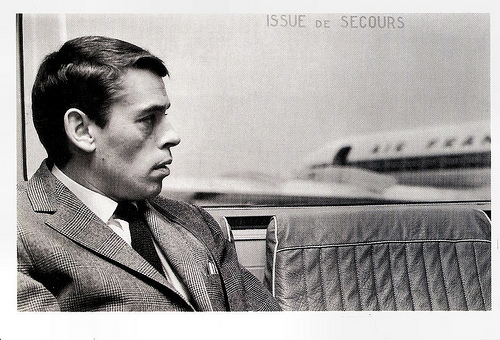
French postcard by Editions F. Nugeron, Star 134. Photo: Air France / Distribution VU. Caption: Jacques Brel, 20 Novembre 1964.
This is a post for Postcard Friendship Friday, hosted by Beth at the The Best Hearts are Crunchy. You can visit her by clicking on the button below.

Source: John Brownlee (Terminal Velocity), and Wikipedia.

German postcard by Kunst und Film Verlag H. Lukow, Hannover, no. L2/1042.
Married in 1954
Who are these film stars on this postcard, posing on the stairs of an airplane or standing nearby? And from which side of the world were they coming?
The pictured film actors are from top left to down right:
Linda Darnell (USA), Tyrone Power (USA), Elizabeth Taylor (UK/USA),
Robert Taylor (USA) and his wife Ursula Thiess (Germany), Gina Lollobrigida (Italy) and her husband, the physician Milko Škofič (Slovenia), Audrey Hepburn (UK) and husband Mel Ferrer (USA),
Mona Baptiste (Trinidad), Mara Lane (UK/Austria) and Gloria DeHaven (USA).
So this curious postcard must date from the mid 1950s. Ursula Thiess and Robert Taylor married in 1954, and Audrey Hepburn and Mel Ferrer also became a couple in 1954.
Below I selected 10 dazzling pictures of these 'Filmschauspieler aus aller Welt' for you. When there was no postcard of a film actor in our collection available (yes, we try to specialise in European stars), I selected an image from that wonderful picture source Flickr. As an extra, I added a postcard with an Air France picture.

German postcard by ISV, no. B 28. Photo: MGM.
Italian actress and photojournalist Gina Lollobrigida (1927), was one of Europe’s most prominent film stars of the 1950s. ‘La Lollo’ was the first European sex symbol of the post war years and she paved the way into Hollywood for her younger colleagues Sophia Loren and Claudia Cardinale.

Collection: Playboy75UK @ Flickr.
American film actress Linda Darnell (1923-1965) progressed from modeling as a child to acting in theatre and film as an adolescent. At the encouragement of her mother, she made her first film in 1939, and appeared in supporting roles in big budget films for 20th Century Fox throughout the 1940s and early 1950s. She rose to fame with co-starring roles opposite Tyrone Power in adventure films, and established a main character career after her role in Forever Amber (1947). She won critical acclaim for her work in Unfaithfully Yours (1948) and A Letter to Three Wives (1949).

German postcard by Wilhelm Schulze-Witteborg Grafischer Betrieb, Wanne-Eickel. Photo: 20th Century Fox.
Beloved Hollywood star Tyrone Power (1914-1958) may have been all-American, but he sure loved European ladies - he was married to both French Annabella and half-Dutch Linda Christian. 'Ty' was one of the great romantic film stars.

German postcard by Krüger, no. 902/20.
British-American actress Elizabeth Taylor (1932-2011) is considered one of the great actresses of Hollywood's Golden Age. She began her career as a child star, and as an adult she became known for her acting talent and beauty. 'Liz' had a much publicised private life, including eight marriages and several near death experiences.

Collection: Maria @ Flickr. Photo: Robert Taylor in 1943.
American film actor Robert Taylor (1911-1969) was one of the most popular leading men of his time. Taylor began his career in films in 1934 when he signed with Metro-Goldwyn-Mayer. His popularity increased during the late 1930s and 1940s with appearances in A Yank at Oxford (1938), Waterloo Bridge (1940), and Bataan (1943). Taylor married actress Ursula Thiess in 1954, and they had two children. He died of lung cancer at the age of 57.

Mexican collectors card, no. 160. Photo: publicity still for The Iron Glove (1954).
German film star Ursula Thiess (1924–2010) was dubbed by Life magazine as the ‘most beautiful woman in the world’. Howard Hughes offered her a long-term contract to RKO, but five years later she gave up her acting career after marrying Robert Taylor. The glamorous, luscious looking actress had only starred in a handful of Hollywood movies.

German postcard by Ufa, Berlin-Tempelhof, no. CK-5. Retail price: 30 Pfg. Photo: Paramount Film.
Elegant, talented and funny Audrey Hepburn (1929-1993) was a Belgian-born, British-Dutch actress and humanitarian. After a start in the European cinema she became one of the most successful Hollywood stars of the 1950s and 1960s.

Collection: Fred Baby @ Flickr. Photo: Mel Ferrer and Audrey Hepburn .
Mel Ferrer (1917-2008) was an American actor, film director, and film producer. He made his screen acting debut in Lost Boundaries (1949), and is best remembered for his roles as the injured puppeteer in the musical Lili (1953), as the villainous Marquis de Maynes in Scaramouche (1952) and as Prince Andrei in War and Peace (1956), co-starring with his then-wife, Audrey Hepburn .

German postcard by UFA, no. CK-200. Photo: Klaus Collignon / UFA.
British-Austrian actress Mara Lane (1930) was considered one of the most beautiful models in Great Britain during the early 1950s. She appeared in more than 30 English and German language films of the 1950s and early 1960s, but seems completely forgotten now.

British postcard in the Celebrity Autographs Series, no. 192. Photo: Universal-International. Publicity still for So This Is Paris (Richard Quine, 1954).
Gloria DeHaven (1925-2016) was an American musical actress, with mostly supporting roles or leading lady in B movies. In Hollywood, she started as a child star then worked as a juvenile actress and finially became a leading-lady. During her long and varied career she would also perform as nightclub singer, as stage actress in Broadway and the West End and as a TV actress and hostess.

French postcard by Editions F. Nugeron, Star 134. Photo: Air France / Distribution VU. Caption: Jacques Brel, 20 Novembre 1964.
This is a post for Postcard Friendship Friday, hosted by Beth at the The Best Hearts are Crunchy. You can visit her by clicking on the button below.

Source: John Brownlee (Terminal Velocity), and Wikipedia.
Published on August 25, 2016 22:00
August 24, 2016
Heli Finkenzeller
German stage and film actress Heli Finkenzeller (1914-1991) had her greatest successes in popular Ufa comedies of the 1930s and 1940s. After the war she often played mother roles.
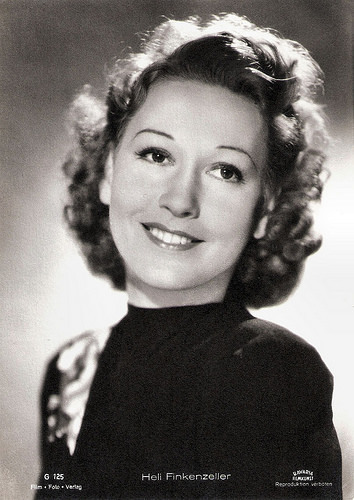
German postcard by Film-Foto-Verlag, no. G 125, Photo: Bavaria Filmkunst.
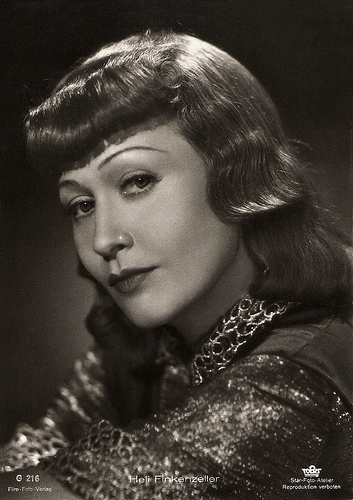
German postcard by Film-Foto-Verlag, no. G 216, 1941-1944. Photo: Star-Foto-Atelier / Tobis.
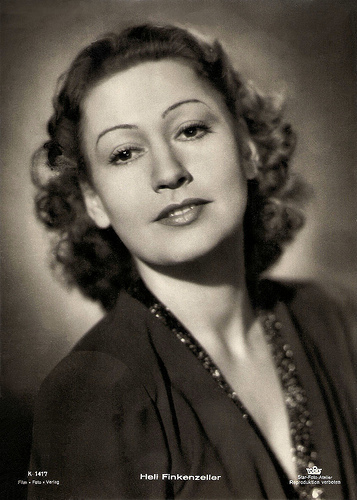
German postcard by Film-Foto-Verlag, no. K 1417. Photo: Tobis / Star-Foto-Atelier.
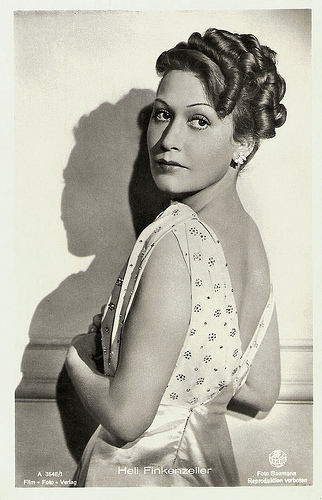
German postcard by Film-Foto-Verlag, no. A 3648/1, 1941-1944. Photo: Baumann / Terra.
Box-office Hits
Helene Finkenzeller was born in München (Munich), Germany in 1914 (according to some sources in 1911). She grew up in Munich where her parents ran a family business which sold office furniture. As a kid she was already interested in everything connected to the theatre and she wanted to become an opera singer.
After finishing school she attended a conservatory, but she soon realised that her voice was too weak for the opera stage. Instead she took acting classes from Otto Falkenberg at his newly established drama school in Munich. In 1934 she joined the Münchner Kammerspielen (Munich Chamber Plays) and for the next two years she performed there with such actors as Ferdinand Marian , Elizabeth Flickenschild, and her later husband Will Dohm.
In 1935 she made her first film appearance in a supporting part in the Ufa comedy Ehestreik/Matrimonial Strike (Georg Jacoby, 1935) with Paul Richter . She played her first lead for the Ufa in the comedy Weiberregiment/Petticoat Government (Karl Ritter, 1936).
Finkenzeller appeared with star comedian Heinz Rühmann in Der Mustergatte/Model Husband (Wolfgang Liebeneiner, 1937).
The box office hits Opernball/Opera Ball (Wolfgang Liebeneiner, 1939) with Paul Hörbiger , Kohlhiesels Töchter/Kohlhiesels daughters (Kurt Hoffmann, 1943) in which she played the double roles of Veronika and Annamirl Kohlhöfer, and especially Das Bad auf der Tenne/The bathroom in the barn (Volker von Collande, 1943) with her husband Will Dohm made her known to a large audience and she became one of Germany’s most popular film stars.
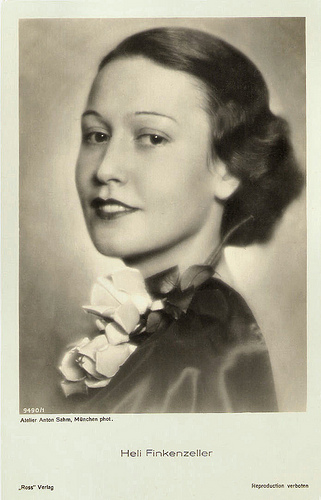
German postcard by Ross Verlag, no. 9490/1, 1935-1936. Photo: Atelier Anton Sahm, München.
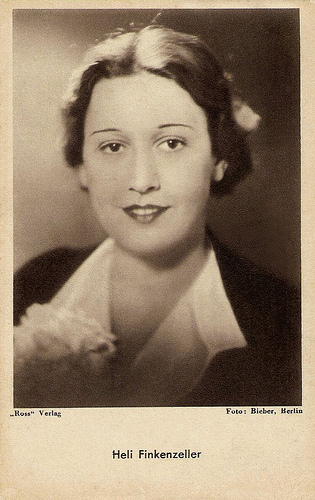
German postcard by Das Programm von Heute für Film und Theater G.m.b.H., Berlin. Photo: Bieber, Berlin / Ross Verlag.
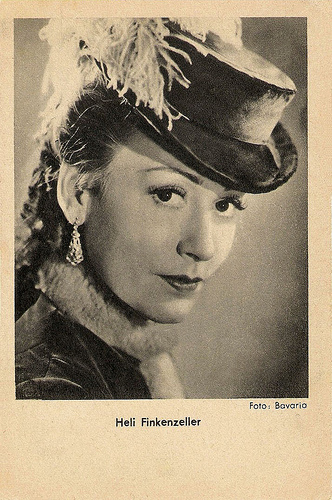
German postcard by Das Programm von Heute für Film und Theater G.m.b.H., Berlin. Photo: Bavaria / Ross Verlag.
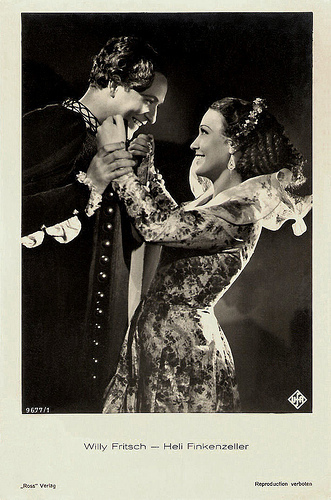
German postcard by Ross Verlag, no. 9677/1, 1935-1936. Photo: Ufa. Publicity still for Boccaccio (Herbert Maisch, 1936) with Willy Fritsch .
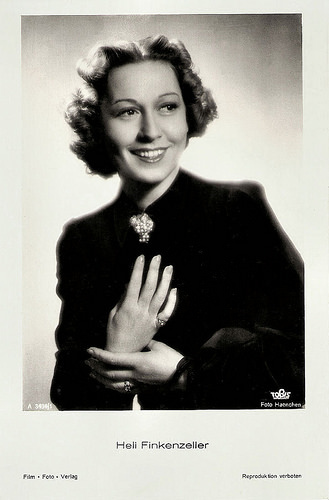
German postcard by Film-Foto-Verlag, no. A 3434/1, 1941-1944. Photo: Tobis / Haenchen.
Big World Allure
After the Second World War, Heli Finkenzeller continued her film career, often in mother roles. Thus she played the wife of Heinz Rühmann in Briefträger Müller/Postman Müller (John Reinhardt, 1953) and Emil’s mother in Emil und die Detektive/Emil and the Detectives (Robert A. Stemmle, 1954) based on the classic children’s book by Erich Kästner.
In the German-Dutch coproduction Ciske - Ein Kind braucht Liebe/Ciske – A Child Needs Love (Wolfgang Staudte, 1955) with Kees Brusse, she was the aunt of the title figure. She was also seen in another Dutch-German coproduction Jenny (Alfred Bittins, Willy van Hemert, 1959) featuring Ellen van Hemert .
On stage, she appeared in the musical Gigi at the Theater des Westens (Theatre of the West) in Berlin, and in many plays. She also can be heard on records with songs and texts.
From the early 1960s on, the former Ufa star played mainly on stage and in many TV films and series, such as Unser Pauker/Our Crammer (Otto Meyer, 1965) with Georg Thomalla, the comedy Meine Schwiegersöhne und ich/My sons-in-law and I (Rudolf Jugert, 1969) opposite Hans Söhnker, the Krimi Der Kommissar/The Commissioner (1974) starring Erik Ode, Das Traumschiff/The Dream Boat (Fritz Umgelter, 1981), Der Gerichtsvollzieher/The Bailiff (Peter Weck, 1981) and finally, three years before her death in Lorentz & Söhne/Lorentz and Sons (Claus Peter Witt, 1988).
In between, she played in one final film, the black comedy Satansbraten/Satan’s Brew (Rainer Werner Fassbinder, 1976). Heli Finkenzeller and Will Dohm had a daughter, actress Gaby Dohm (1943) who is well known in the German language countries. After Will Dohm’s death in 1948, Heli remarried in 1950 to film producer Alfred Bittin. They stayed together till his death in 1971.
Heli Finkenzeller died from cancer in 1991 in her hometown Munich. She was 76. The German weekly Der Spiegel wrote in an obituary: “Her type was much in demand at the UFA: charm with distance, elegance without any wickedness. She even had big world allure, but on a small Pan-German scale. It made Heli Finkenzeller in the middle of the thirties a star in light entertainment films.”
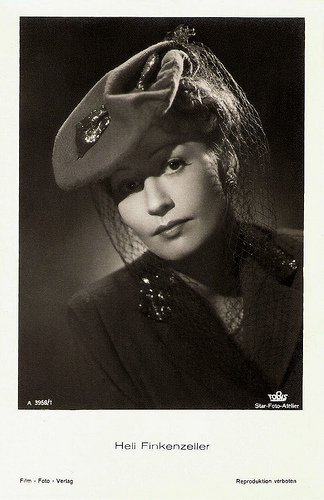
German postcard by Film-Foto-Verlag, no. A 3958/1, 1941-1944. Photo: Star-Foto-Atelier / Tobis.
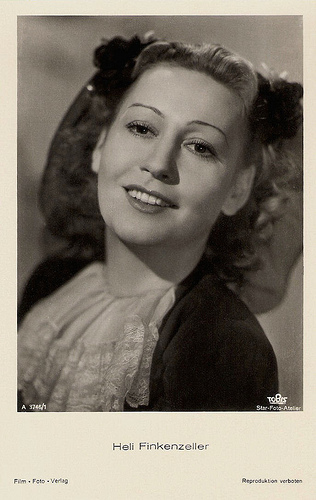
German postcard by Film-Foto-Verlag, no. A 3746/1, 1941-1944. Photo: Star-Foto-Atelier / Tobis.
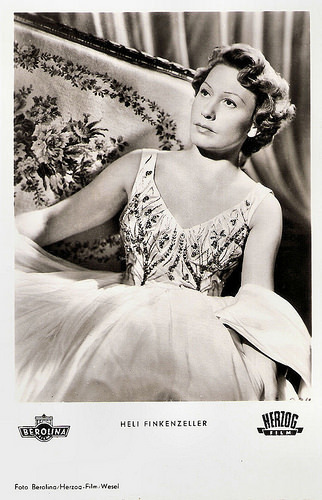
German postcard by Film und Bild, Berlin, no. A 916. Photo: Berolina / Herzog-Film / Wesel. Publicity still for Briefträger Müller/Mailman Mueller (John Reinhardt, 1953).
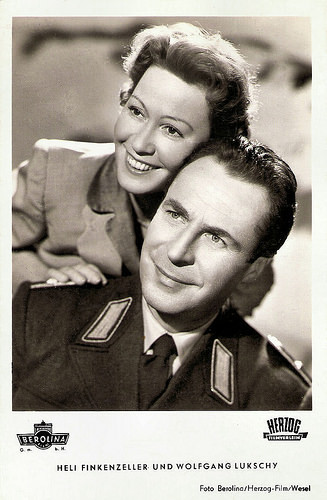
German postcard by Kunst und Bild, Berlin, no. A 1235. Photo: Berolina / Herzog-Film / Wesel. Publicity still for Emil und die Detektive/Emil and the Detectives (Robert A. Stemmle, 1954) with Wolfgang Lukschy.
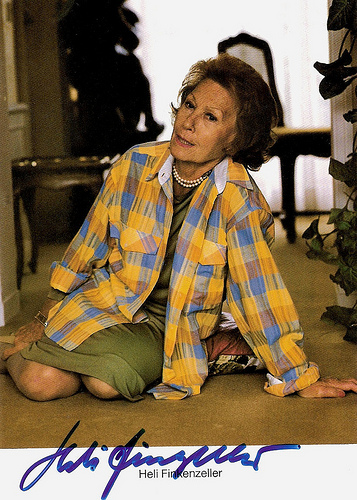
German postcard by Franz Josef Rüdel, Filmpostkartenverlag, Hamburg. Photo: Christian Pantel, Hamburg.
Heli Finkenzeller sings Heute möchte ich, with Theo Lingen and Marte Harell in Opernball/Opera Ball (1939). Source: BD 130 (YouTube).
Sources: Stephanie D’Heil (Steffi-Line) (German), Thomas Staedeli (Cyranos), Der Spiegel (German), Wikipedia (German), and .

German postcard by Film-Foto-Verlag, no. G 125, Photo: Bavaria Filmkunst.

German postcard by Film-Foto-Verlag, no. G 216, 1941-1944. Photo: Star-Foto-Atelier / Tobis.

German postcard by Film-Foto-Verlag, no. K 1417. Photo: Tobis / Star-Foto-Atelier.

German postcard by Film-Foto-Verlag, no. A 3648/1, 1941-1944. Photo: Baumann / Terra.
Box-office Hits
Helene Finkenzeller was born in München (Munich), Germany in 1914 (according to some sources in 1911). She grew up in Munich where her parents ran a family business which sold office furniture. As a kid she was already interested in everything connected to the theatre and she wanted to become an opera singer.
After finishing school she attended a conservatory, but she soon realised that her voice was too weak for the opera stage. Instead she took acting classes from Otto Falkenberg at his newly established drama school in Munich. In 1934 she joined the Münchner Kammerspielen (Munich Chamber Plays) and for the next two years she performed there with such actors as Ferdinand Marian , Elizabeth Flickenschild, and her later husband Will Dohm.
In 1935 she made her first film appearance in a supporting part in the Ufa comedy Ehestreik/Matrimonial Strike (Georg Jacoby, 1935) with Paul Richter . She played her first lead for the Ufa in the comedy Weiberregiment/Petticoat Government (Karl Ritter, 1936).
Finkenzeller appeared with star comedian Heinz Rühmann in Der Mustergatte/Model Husband (Wolfgang Liebeneiner, 1937).
The box office hits Opernball/Opera Ball (Wolfgang Liebeneiner, 1939) with Paul Hörbiger , Kohlhiesels Töchter/Kohlhiesels daughters (Kurt Hoffmann, 1943) in which she played the double roles of Veronika and Annamirl Kohlhöfer, and especially Das Bad auf der Tenne/The bathroom in the barn (Volker von Collande, 1943) with her husband Will Dohm made her known to a large audience and she became one of Germany’s most popular film stars.

German postcard by Ross Verlag, no. 9490/1, 1935-1936. Photo: Atelier Anton Sahm, München.

German postcard by Das Programm von Heute für Film und Theater G.m.b.H., Berlin. Photo: Bieber, Berlin / Ross Verlag.

German postcard by Das Programm von Heute für Film und Theater G.m.b.H., Berlin. Photo: Bavaria / Ross Verlag.

German postcard by Ross Verlag, no. 9677/1, 1935-1936. Photo: Ufa. Publicity still for Boccaccio (Herbert Maisch, 1936) with Willy Fritsch .

German postcard by Film-Foto-Verlag, no. A 3434/1, 1941-1944. Photo: Tobis / Haenchen.
Big World Allure
After the Second World War, Heli Finkenzeller continued her film career, often in mother roles. Thus she played the wife of Heinz Rühmann in Briefträger Müller/Postman Müller (John Reinhardt, 1953) and Emil’s mother in Emil und die Detektive/Emil and the Detectives (Robert A. Stemmle, 1954) based on the classic children’s book by Erich Kästner.
In the German-Dutch coproduction Ciske - Ein Kind braucht Liebe/Ciske – A Child Needs Love (Wolfgang Staudte, 1955) with Kees Brusse, she was the aunt of the title figure. She was also seen in another Dutch-German coproduction Jenny (Alfred Bittins, Willy van Hemert, 1959) featuring Ellen van Hemert .
On stage, she appeared in the musical Gigi at the Theater des Westens (Theatre of the West) in Berlin, and in many plays. She also can be heard on records with songs and texts.
From the early 1960s on, the former Ufa star played mainly on stage and in many TV films and series, such as Unser Pauker/Our Crammer (Otto Meyer, 1965) with Georg Thomalla, the comedy Meine Schwiegersöhne und ich/My sons-in-law and I (Rudolf Jugert, 1969) opposite Hans Söhnker, the Krimi Der Kommissar/The Commissioner (1974) starring Erik Ode, Das Traumschiff/The Dream Boat (Fritz Umgelter, 1981), Der Gerichtsvollzieher/The Bailiff (Peter Weck, 1981) and finally, three years before her death in Lorentz & Söhne/Lorentz and Sons (Claus Peter Witt, 1988).
In between, she played in one final film, the black comedy Satansbraten/Satan’s Brew (Rainer Werner Fassbinder, 1976). Heli Finkenzeller and Will Dohm had a daughter, actress Gaby Dohm (1943) who is well known in the German language countries. After Will Dohm’s death in 1948, Heli remarried in 1950 to film producer Alfred Bittin. They stayed together till his death in 1971.
Heli Finkenzeller died from cancer in 1991 in her hometown Munich. She was 76. The German weekly Der Spiegel wrote in an obituary: “Her type was much in demand at the UFA: charm with distance, elegance without any wickedness. She even had big world allure, but on a small Pan-German scale. It made Heli Finkenzeller in the middle of the thirties a star in light entertainment films.”

German postcard by Film-Foto-Verlag, no. A 3958/1, 1941-1944. Photo: Star-Foto-Atelier / Tobis.

German postcard by Film-Foto-Verlag, no. A 3746/1, 1941-1944. Photo: Star-Foto-Atelier / Tobis.

German postcard by Film und Bild, Berlin, no. A 916. Photo: Berolina / Herzog-Film / Wesel. Publicity still for Briefträger Müller/Mailman Mueller (John Reinhardt, 1953).

German postcard by Kunst und Bild, Berlin, no. A 1235. Photo: Berolina / Herzog-Film / Wesel. Publicity still for Emil und die Detektive/Emil and the Detectives (Robert A. Stemmle, 1954) with Wolfgang Lukschy.

German postcard by Franz Josef Rüdel, Filmpostkartenverlag, Hamburg. Photo: Christian Pantel, Hamburg.
Heli Finkenzeller sings Heute möchte ich, with Theo Lingen and Marte Harell in Opernball/Opera Ball (1939). Source: BD 130 (YouTube).
Sources: Stephanie D’Heil (Steffi-Line) (German), Thomas Staedeli (Cyranos), Der Spiegel (German), Wikipedia (German), and .
Published on August 24, 2016 22:00
August 23, 2016
New episode unveiled of Floris (1969)
Nearly 47 years after the broadcast of the twelfth and final episode of the legendary TV series Floris, a hitherto unknown thirteenth episode premiered last Friday. The premiere happened at Doornenburg castle, one of the locations of the Dutch television series.
Floris
started three of the most successful careers in the history of the Dutch cinema. It's directed by Paul Verhoeven, written by Gerard Soeteman and starring the young Rutger Hauer. Hauer, now 72, was present at the belated premiere.
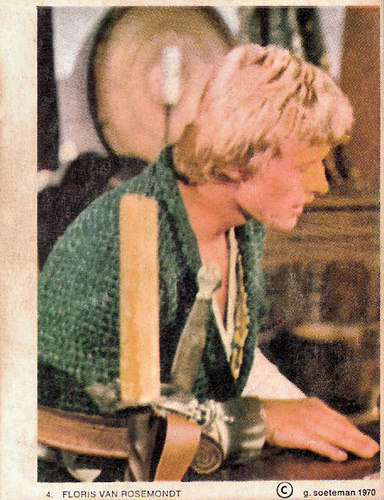
Dutch collectors card, no. 4, 1970. Photo: Gerard Soeteman. Publicity still for the TV series Floris (Paul Verhoeven, 1969). Rutger Hauer as Floris van Rosemondt.
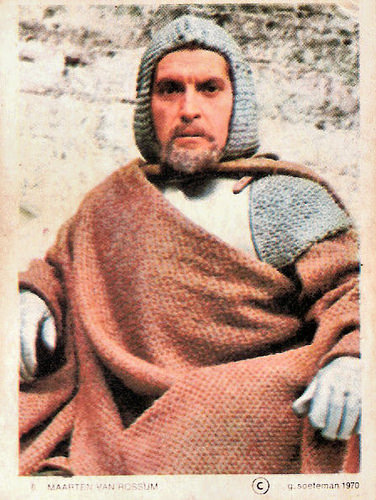
Dutch collectors card, no. 5 (?), 1970. Photo: Gerard Soeteman. Publicity still for the TV series Floris (Paul Verhoeven, 1969). Hans Culeman as Maarten van Rossum.

Dutch collectors card, no. 7, 1970. Photo: Gerard Soeteman. Publicity still for the TV series Floris (Paul Verhoeven, 1969). Hans Boskamp as Lange Pier.
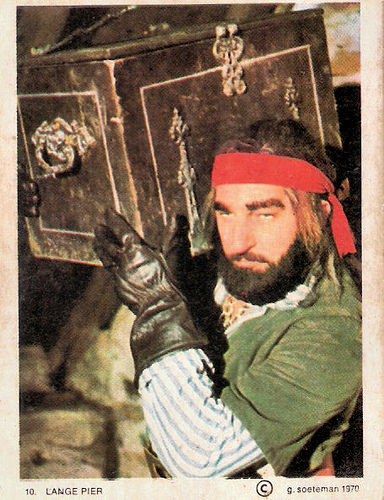
Dutch collectors card, no. 10, 1970. Photo: Gerard Soeteman. Publicity still for the TV series Floris (Paul Verhoeven, 1969). Hans Boskamp as Lange Pier.

Dutch collectors card, no. 14, 1970. Photo: Gerard Soeteman. Publicity still for the TV series Floris (Paul Verhoeven, 1969).
Unforgettable screen debut
I was able to lay my hands on some vintage collectors cards of Floris (1969). These small cards, produced in 1970, are quite rare these days, and therefor my series is not complete yet.
The Dutch television series, set in the Middle Ages, is the favourite series for many of my generation in the Netherlands and also in Belgium. At the time, all kinds of merchandise was produced for the kids and of course they are a cult now.
In the series, blonde, athletic and the then incredibly young Rutger Hauer made his screen debut as the exiled knight Floris van Rosemondt. His performance is unforgettable, Hauer is the ultimate knight.
With his Indian friend Sindala (Jos Bergman), Floris tries to get his birth right papers back from Maarten van Rossem (Hans Culeman), an evil lord.
During their quest they get help from Wolter van Oldenstein (Ton Vos), a noble man who offers them a place in his castle. They also meet the imposing pirate Lange Pier (Hans Boskamp).
Apart from Sindala and Floris, all the characters are based on historical figures. Scriptwriter Gerard Soeteman did an amazingly inventive job and it is one of the reasons why many adults love to see this children's series too.
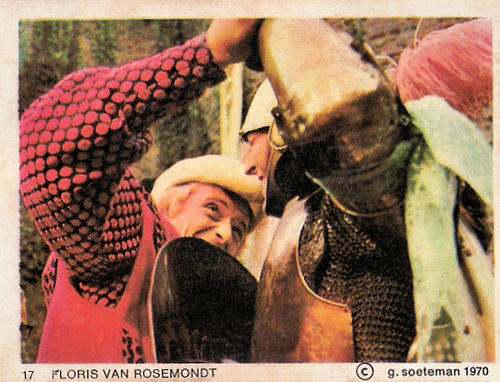
Dutch collectors card, no. 17, 1970. Photo: Gerard Soeteman. Publicity still for the TV series Floris (Paul Verhoeven, 1969).
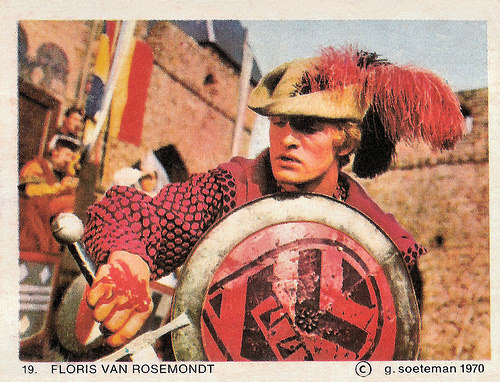
Dutch collectors card, no. 19, 1970. Photo: Gerard Soeteman. Publicity still for the TV series Floris (Paul Verhoeven, 1969).
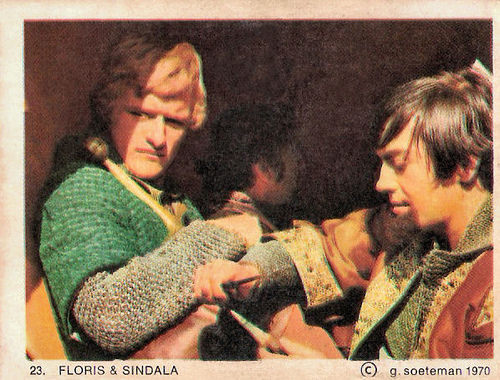
Dutch collectors card, no. 23, 1970. Photo: Gerard Soeteman. Publicity still for the TV series Floris (Paul Verhoeven, 1969).
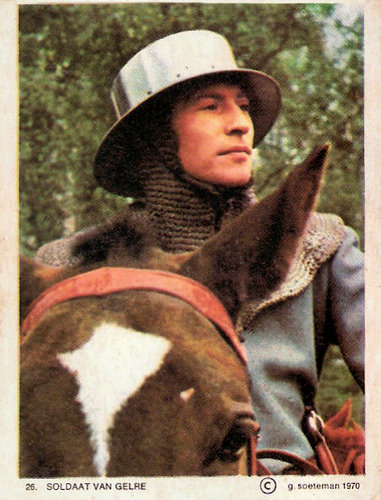
Dutch collectors card, no. 26, 1970. Photo: Gerard Soeteman. Publicity still for the TV series Floris (Paul Verhoeven, 1969). Caption: Soldaat van Gelre (Soldier Van Gelre).
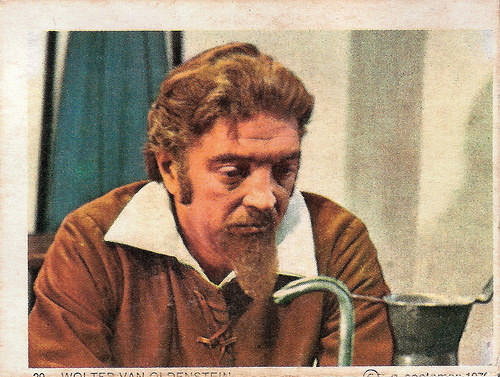
Dutch collectors card, no. 29 (?), 1970. Photo: Gerard Soeteman. Publicity still for the TV series Floris (Paul Verhoeven, 1969). Ton Vos als Wolter van Oldenstein.
In the best Robin Hood style
In 1967, the success of television series like the British Ivanhoe (1958-1959) with Roger Moore , the French Thierry La Fronde/Thierry the Sling (1963-1966) with Jean-Claude Drouot , and the Flemish Johan en de Alverman (1965) with Frank Aendenboom inspired Carel Enkelaar, manager of NTS Television to make a similar series, set in the Netherlands.
Hanne Aboe Derwort highly recommends the series at IMDb : "One of the first Middle Age series ever, the stories of the adventures of Floris in medieval Holland are also among the most funny tv-series ever.
The budget was very low, which can be seen, but the interaction between the actors is nothing less but wonderful. Floris and his trusty companion Sindala is in best Robin Hood style, but with the addition of Eastern magic to the sword fighting skills and sheer strength (and luck) of our hero. (...)
The fact that the series is in b/w actually helps, no need to mess around with anything when somebody's wounded. If you can locate the tapes, watch it."

Dutch collectors card, no. 30, 1970. Photo: Gerard Soeteman. Publicity still for the TV series Floris (Paul Verhoeven, 1969).
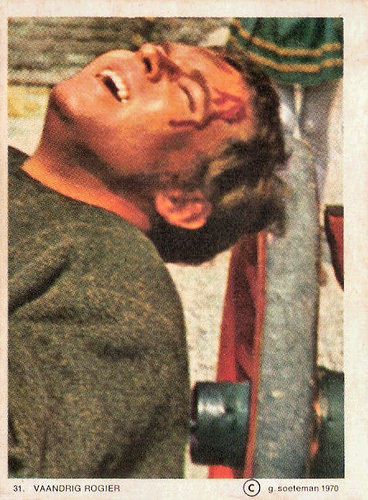
Dutch collectors card, no. 31, 1970. Photo: Gerard Soeteman. Publicity still for the TV series Floris (Paul Verhoeven, 1969). Caption: Vaandrig Rogier (Ensign-bearer Rogier). Rogier was played by Jacco van Renesse.
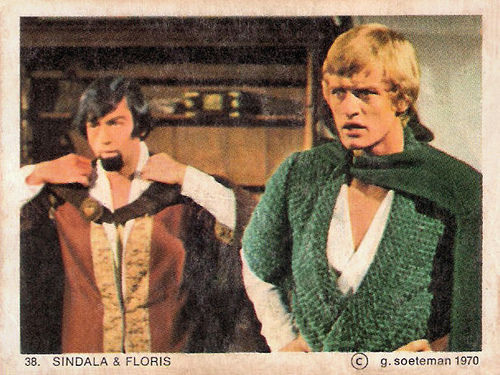
Dutch collectors card, no. 38, 1970. Photo: Gerard Soeteman. Publicity still for the TV series Floris (Paul Verhoeven, 1969).
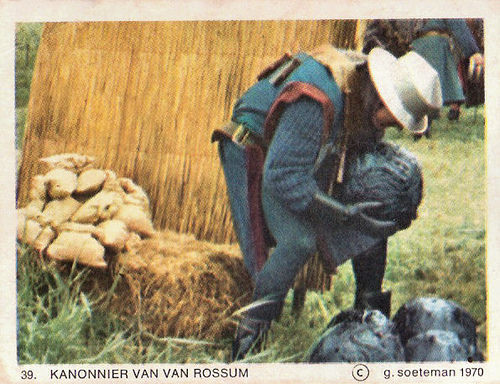
Dutch collectors card, no. 39, 1970. Photo: Gerard Soeteman. Publicity still for the TV series Floris (Paul Verhoeven, 1969). Caption: Kanonnier van Van Rossum (Gunner of Van Rossum).
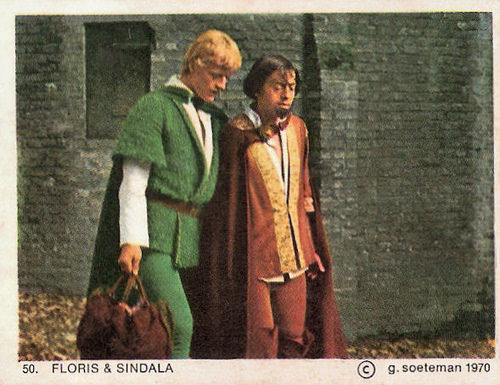
Dutch collectors card, no. 50, 1970. Photo: Gerard Soeteman. Publicity still for the TV series Floris (Paul Verhoeven, 1969).
The most popular TV series in the Netherlands
In 1969, Floris was the most popular TV series in the Netherlands. The series had many reruns through the years.
Floris has also been shown in East Germany (as Floris - Der Mann mit dem Schwert) and Scotland dubbed in English. In the UK, the series aired on Yorkshire Television in 1970 as The Adventures of Floris. None of the English dubbed episodes survive.
1975 saw a German remake of the series, Floris von Rosenmund (Ferry Radax, 1975), again starring Rutger Hauer , but with German actor Derval de Faria as Sindala. This version put much more emphasis on the comedic aspects of the stories.
The series also lead to the film Floris (Jean van de Velde, 2004) which features Michiel Huisman (known for his role in Game of Thrones) as the grandson of the original Floris. Some of the footage from the 1969 series with Hauer and Bergman is included. Rutger Hauer was originally asked to play the father of young Floris, but he declined.
A thirteenth episode of the series, entitled Het gericht/Targeting was never finished for several reasons. The raw footage was owned by the writer of the series, Gerard Soeteman. To get a full episode, there are now between the images black and white drawings assembled by artist Gerrit Stapel, who previously has made the Floris comics together with Soeteman. In addition to the thirteenth episode, a documentary about the legendary series was presented last Friday, in which both Verhoeven and Soeteman provide insight into the development of Floris.
Episode Het brandende water (The burning water). Sorry, no subtitles. Source: eikcid (YouTube).
Dutch TV documentary in the series Andere tijden (Other times). Sorry, no subtitles. Source: 192TVideo (YouTube).
Source: Hanne Aboe Derwort (IMDb), Wikipedia and IMDb.

Dutch collectors card, no. 4, 1970. Photo: Gerard Soeteman. Publicity still for the TV series Floris (Paul Verhoeven, 1969). Rutger Hauer as Floris van Rosemondt.

Dutch collectors card, no. 5 (?), 1970. Photo: Gerard Soeteman. Publicity still for the TV series Floris (Paul Verhoeven, 1969). Hans Culeman as Maarten van Rossum.

Dutch collectors card, no. 7, 1970. Photo: Gerard Soeteman. Publicity still for the TV series Floris (Paul Verhoeven, 1969). Hans Boskamp as Lange Pier.

Dutch collectors card, no. 10, 1970. Photo: Gerard Soeteman. Publicity still for the TV series Floris (Paul Verhoeven, 1969). Hans Boskamp as Lange Pier.

Dutch collectors card, no. 14, 1970. Photo: Gerard Soeteman. Publicity still for the TV series Floris (Paul Verhoeven, 1969).
Unforgettable screen debut
I was able to lay my hands on some vintage collectors cards of Floris (1969). These small cards, produced in 1970, are quite rare these days, and therefor my series is not complete yet.
The Dutch television series, set in the Middle Ages, is the favourite series for many of my generation in the Netherlands and also in Belgium. At the time, all kinds of merchandise was produced for the kids and of course they are a cult now.
In the series, blonde, athletic and the then incredibly young Rutger Hauer made his screen debut as the exiled knight Floris van Rosemondt. His performance is unforgettable, Hauer is the ultimate knight.
With his Indian friend Sindala (Jos Bergman), Floris tries to get his birth right papers back from Maarten van Rossem (Hans Culeman), an evil lord.
During their quest they get help from Wolter van Oldenstein (Ton Vos), a noble man who offers them a place in his castle. They also meet the imposing pirate Lange Pier (Hans Boskamp).
Apart from Sindala and Floris, all the characters are based on historical figures. Scriptwriter Gerard Soeteman did an amazingly inventive job and it is one of the reasons why many adults love to see this children's series too.

Dutch collectors card, no. 17, 1970. Photo: Gerard Soeteman. Publicity still for the TV series Floris (Paul Verhoeven, 1969).

Dutch collectors card, no. 19, 1970. Photo: Gerard Soeteman. Publicity still for the TV series Floris (Paul Verhoeven, 1969).

Dutch collectors card, no. 23, 1970. Photo: Gerard Soeteman. Publicity still for the TV series Floris (Paul Verhoeven, 1969).

Dutch collectors card, no. 26, 1970. Photo: Gerard Soeteman. Publicity still for the TV series Floris (Paul Verhoeven, 1969). Caption: Soldaat van Gelre (Soldier Van Gelre).

Dutch collectors card, no. 29 (?), 1970. Photo: Gerard Soeteman. Publicity still for the TV series Floris (Paul Verhoeven, 1969). Ton Vos als Wolter van Oldenstein.
In the best Robin Hood style
In 1967, the success of television series like the British Ivanhoe (1958-1959) with Roger Moore , the French Thierry La Fronde/Thierry the Sling (1963-1966) with Jean-Claude Drouot , and the Flemish Johan en de Alverman (1965) with Frank Aendenboom inspired Carel Enkelaar, manager of NTS Television to make a similar series, set in the Netherlands.
Hanne Aboe Derwort highly recommends the series at IMDb : "One of the first Middle Age series ever, the stories of the adventures of Floris in medieval Holland are also among the most funny tv-series ever.
The budget was very low, which can be seen, but the interaction between the actors is nothing less but wonderful. Floris and his trusty companion Sindala is in best Robin Hood style, but with the addition of Eastern magic to the sword fighting skills and sheer strength (and luck) of our hero. (...)
The fact that the series is in b/w actually helps, no need to mess around with anything when somebody's wounded. If you can locate the tapes, watch it."

Dutch collectors card, no. 30, 1970. Photo: Gerard Soeteman. Publicity still for the TV series Floris (Paul Verhoeven, 1969).

Dutch collectors card, no. 31, 1970. Photo: Gerard Soeteman. Publicity still for the TV series Floris (Paul Verhoeven, 1969). Caption: Vaandrig Rogier (Ensign-bearer Rogier). Rogier was played by Jacco van Renesse.

Dutch collectors card, no. 38, 1970. Photo: Gerard Soeteman. Publicity still for the TV series Floris (Paul Verhoeven, 1969).

Dutch collectors card, no. 39, 1970. Photo: Gerard Soeteman. Publicity still for the TV series Floris (Paul Verhoeven, 1969). Caption: Kanonnier van Van Rossum (Gunner of Van Rossum).

Dutch collectors card, no. 50, 1970. Photo: Gerard Soeteman. Publicity still for the TV series Floris (Paul Verhoeven, 1969).
The most popular TV series in the Netherlands
In 1969, Floris was the most popular TV series in the Netherlands. The series had many reruns through the years.
Floris has also been shown in East Germany (as Floris - Der Mann mit dem Schwert) and Scotland dubbed in English. In the UK, the series aired on Yorkshire Television in 1970 as The Adventures of Floris. None of the English dubbed episodes survive.
1975 saw a German remake of the series, Floris von Rosenmund (Ferry Radax, 1975), again starring Rutger Hauer , but with German actor Derval de Faria as Sindala. This version put much more emphasis on the comedic aspects of the stories.
The series also lead to the film Floris (Jean van de Velde, 2004) which features Michiel Huisman (known for his role in Game of Thrones) as the grandson of the original Floris. Some of the footage from the 1969 series with Hauer and Bergman is included. Rutger Hauer was originally asked to play the father of young Floris, but he declined.
A thirteenth episode of the series, entitled Het gericht/Targeting was never finished for several reasons. The raw footage was owned by the writer of the series, Gerard Soeteman. To get a full episode, there are now between the images black and white drawings assembled by artist Gerrit Stapel, who previously has made the Floris comics together with Soeteman. In addition to the thirteenth episode, a documentary about the legendary series was presented last Friday, in which both Verhoeven and Soeteman provide insight into the development of Floris.
Episode Het brandende water (The burning water). Sorry, no subtitles. Source: eikcid (YouTube).
Dutch TV documentary in the series Andere tijden (Other times). Sorry, no subtitles. Source: 192TVideo (YouTube).
Source: Hanne Aboe Derwort (IMDb), Wikipedia and IMDb.
Published on August 23, 2016 22:00
August 22, 2016
Pierre Fresnay
One of the most important French stage and film actors of his era was Pierre Fresnay (1897-1975). He abandoned a career with the Comédie-Française for the challenge of the cinema, and appeared in more than sixty films. His best known films include Marius (1931), Hitchcock's first version of The Man Who Knew Too Much (1934), and Renoir’s epic La Grande Illusion (1937). From WW I he returned as a hero, but after WW II he was detained in prison while allegations of collaboration were investigated.

French postcard by EC, no. 94. Photo: G.L. Manuel Frères.

Italian programme card for Il Cinema Ritrovata 2012. Photo: publicity still for La Grande Illusion (Jean Renoir, 1937) with Jean Gabin and Pierre Fresnay.

French postcard by Viny, no. 86. Photo: Vedis-Film. Publicity still for Les trois valses/Three Waltzes (Ludwig Berger, 1938).

French postcard by SERP, Paris, no. 35. Photo: Studio Harcourt.
Marius
Pierre Fresnay was born Pierre Jules Louis Laudenbach in Paris, France in 1897. He was the son of Jean Henri Laudenbach, professor philosophy, and Désirée Claire Dietz.
At 14, Pierre made his stage debut. His uncle, the actor Claude Garry encouraged him to pursue a career in theatre and film, and arranged a small role for him in L’Aigrette by Dario Niccodemi at the Theatre Rejane. This was against the wishes of his parents who had hoped Pierre might pursue a university career. On this occasion he chose his first stage name, Pierre Vernet.
In 1914, he entered the Conservatoire national de musique et de déclamation (National Conservatory of Music and Declamation in Paris), in a class with Mounet Paul and Georges Berr. Only 19, he was hired by the prestigious Comédie-Française as a pensionnaire (contract player). He had his first major theater role in Le Jeu de l'amour et du hasard (The Game of Love and Chance) in 1915.
That same year he made his silent film debut with a small role in the patriotic drama France d'abord/First France (Henri Pouctal, 1915) with André Luguet . World War I was raging, and in 1917 he enlisted as a soldier in the French Army. After the war, he returned to his career as a hero.
Throughout the 1920s, Fresnay appeared in many popular stage productions. He became a sociétaire (life member) of the Comédie-Française four years before he resigned in 1927. During the next 10 years he worked in England and the United States as well as in France. He was outstanding in the title roles in Cyrano de Bergerac (1928) and Don Juan (London, 1934). He had his greatest stage success in the title role of Marcel Pagnol’s Marius (1929). The play ran for over 500 performances.

French postcard, no. H 3. Photo: Jim.

French postcard by Collection Chantal, Paris, no. 4. Photo: Védis Films. Publicity still for Les trois valses/Three Waltzes (Ludwig Berger, 1938).

French postcard by Edit. Chantal, Rueil (S.O.), no. 94A. Photo: Védis Films. Publicity still for Les trois valses/Three Waltzes (Ludwig Berger, 1938).

French postcard by Edit. Chantal, Rueil (S.O.), no. 94. Photo: Védis Films. Publicity still for Les trois valses/Three Waltzes (Ludwig Berger, 1938).
A Breath of Fresh Air
Pierre Fresnay’s first great screen role was also as Marius in the film adaptation of Pagnol’s play, Marius (Alexander Korda, 1931). At Le Film Guide , James Travers writes: “Marius offered an unembellished slice of life in the southern French port which came as a breath of fresh air to audiences of the time. What was so refreshing about the film was its total lack of artifice. The story it tells is a simple one which anyone who saw it could relate to. It deals with everyday themes - the rift between parents and their grown-up children, the pains and practicalities of falling in love, the difficulty of reconciling personal ambitions with the emotional need for love and stability.”
The part established Fresnay’s reputation as a cinema actor and made him an instant matinee idol. He played Marius again in the next two parts of Marcel Pagnol's Marseilles Trilogy, Fanny (1932, Marc Allégret) featuring Orane Demazis, and César (1936, Marcel Pagnol) starring Raimu .
In 1934, he played Armand Duval in La Dame aux Camelias/Lady of the Camelias (Fernand Rivers, Abel Gance, 1934) at the side of Yvonne Printemps . The two married that same year. They appeared in eight films together, including the film operetta Trois Valses/Three Waltzes (Ludwig Berger, 1938).
Fresnay also appeared as the first-reel murder victim in Alfred Hitchcock's first version of The Man Who Knew Too Much (Alfred Hitchcock, 1934) with Leslie Banks and Peter Lorre .
A highpoint in his film career was his appearance as the young French officer opposite Erich von Stroheim in the anti-war epic La Grande Illusion/Grand Illusion (Jean Renoir, 1937). James Travers: “One of the undisputed masterpieces of cinema history, La Grande illusion is a film of enduring popularity and one of the most powerful anti-war films of the Twentieth century. It stands beside Jean Renoir’s other triumph, La Regle du jeu, as one of the all-time great French films.”
With the collaboration of an unknown script writer, Henri-Georges Clouzot, Fresnay directed his one and only film Le Duel/The Duel (Pierre Fresnay, 1939), starring Yvonne Printemps . According to James Travers, Le Duel “was a mediocre effort which was soon forgotten with the outbreak of World War Two”.

French postcard, no. 94. Photo: Films Derby. Publicity still for Le puritain/The Puritan (Jeff Musso, 1938).

French postcard by Erpé, no. 625. Photo: C.F.C.

French postcard by Editions E.C., Paris, no. 7. Photo: C.P.L.F.

French postcard by Editions P.I., Paris, no. 150. Photo: Pathé Cinema.
Subversive and Immoral Overtones
Under the Nazi occupation of France, Pierre Fresnay worked for the Franco-German film company Continental, which was closely vetted by the Germans.
Fresnay appeared in a number of high quality productions, including a number of films written or directed by his close friend Henri-Georges Clouzot. These included the comedy thriller Le Dernier des Six/The Last One of the Six (Georges Lacombe, 1941), where Fresnay played the part of the cool (but patient) Commissioner Wens.
He reprised the role for Clouzot’s directoral debut, L’Assassin habite au 21/The Murderer Lives at Number 21 (Henri-Georges Clouzot, 1942) with the bubbling Suzy Delair as Wens’ girlfriend.
Fresnay later also starred in Clouzot’s most controversial film Le Corbeau/The Raven (Henri-Georges Clouzot, 1943), which created such an uproar that its director was temporarily banned from making films.
James Travers at Le Film Guide : “The film was banned after the war because of its perceived subversive and immoral overtones. The story was based on a real-life case which took place in the French town of Tulle in the 1920’s. The film is an excellent suspense thriller, easily in the league of Clouzot’s subsequent films of this genre (Le Salaire de la peur/The Wages of Fear (1953) and Les Diaboliques/Diabolique (1954)).”

French postcard by Editions O.P., Paris, no. 205. Photo: Teddy Piaz, Paris.

French postcard by A. Noyer, no. 1291. Photo: Raymond Voinquel, Paris.

French postcard, no. 94. Photo: C.P.L.F.

French postcard, no. 153.
I Am An Actor
After the war, Pierre Fresnay was detained in prison while allegations of collaboration were investigated. After being held for six weeks, he was released as a result of a lack of evidence. Despite Fresnay’s declarations that he worked in films to help save the French film industry in a period of crisis, the move damaged his popularity with the public. For the remainder of his film career, he would appear mainly in lesser roles in comparatively minor films.
There are some exceptions. In 1947 he played Vincent de Paul (namesake of the Vincent de Paul Society) in Monsieur Vincent (Maurice Cloche, 1947), for which he won the Volpi cup for best actor at the Venice Film Festival. Monsieur Vincent was the first French language film to win an Academy Award (in 1948).
Another success was Dieu a besoin des homes/God Needs Men (Jean Delannoy, 1950) with Madeleine Robinson , for which he was nominated for a BAFTA award, the British Oscar. Fresnay also portrayed Nobel Peace Prize laureate Albert Schweitzer in Il est minuit, Docteur Schweitzer/It Is Midnight Dr. Schweitzer (André Haguet, 1952).
In 1954, he published his memoirs, Je suis comédien (I am an actor). His last film was the comedy Les Vieux de la vieille/The Old Chaps (Gilles Grangier, 1960) with Jean Gabin . Throughout his career, he had maintained that he was a stage actor first and a film actor second. The cinema had clearly less appeal to him.
Pierre Fresnay continued to perform regularly on stage through to the 1960s and 1970s. In the early 1970s, he appeared in a few films for television. From then on, he co-directed with Yvonne Printemps the Théâtre de la Michodière in Paris until his death in 1975.
Pierre Fresnay died of respiratory problems at the age of 77 at Neuilly-sur-Seine and is interred there side by side with Printemps in the Neuilly-sur-Seine community cemetery. Before marrying Printemps he had married and divorced actresses Rachel Berendt (1917-1920) and Berthe Dovy (1923–1929). Asked how to say his name, he told The Literary Digest "I think my name is to be pronounced fray-nay. At least, it is the way I pronounce it."
French trailer for the DVD Marseille Trilogy after the restaurayion in 2016. Source: Digital Ciné (YouTube).
Trailer for La Grande Illusion/Grand Illusion (1937). Source: Danios 12345 (YouTube).
Trailer for Le Corbeau/The Raven (1943). Source: Dyran (YouTube).
French trailer for Monsieur Vincent (1947). Source: Lionsgate VOD (YouTube).
Sources: James Travers (Le Film Guide), Christian Grenier (L’encinémathèque - French), Caroline Hanotte (CinéArtistes - French), Hal Erickson (AllMovie), Thomas Staedeli (Cyranos), AlloCiné (French), Encyclopedia Brittanica, Wikipedia (French and English), and .

French postcard by EC, no. 94. Photo: G.L. Manuel Frères.

Italian programme card for Il Cinema Ritrovata 2012. Photo: publicity still for La Grande Illusion (Jean Renoir, 1937) with Jean Gabin and Pierre Fresnay.

French postcard by Viny, no. 86. Photo: Vedis-Film. Publicity still for Les trois valses/Three Waltzes (Ludwig Berger, 1938).

French postcard by SERP, Paris, no. 35. Photo: Studio Harcourt.
Marius
Pierre Fresnay was born Pierre Jules Louis Laudenbach in Paris, France in 1897. He was the son of Jean Henri Laudenbach, professor philosophy, and Désirée Claire Dietz.
At 14, Pierre made his stage debut. His uncle, the actor Claude Garry encouraged him to pursue a career in theatre and film, and arranged a small role for him in L’Aigrette by Dario Niccodemi at the Theatre Rejane. This was against the wishes of his parents who had hoped Pierre might pursue a university career. On this occasion he chose his first stage name, Pierre Vernet.
In 1914, he entered the Conservatoire national de musique et de déclamation (National Conservatory of Music and Declamation in Paris), in a class with Mounet Paul and Georges Berr. Only 19, he was hired by the prestigious Comédie-Française as a pensionnaire (contract player). He had his first major theater role in Le Jeu de l'amour et du hasard (The Game of Love and Chance) in 1915.
That same year he made his silent film debut with a small role in the patriotic drama France d'abord/First France (Henri Pouctal, 1915) with André Luguet . World War I was raging, and in 1917 he enlisted as a soldier in the French Army. After the war, he returned to his career as a hero.
Throughout the 1920s, Fresnay appeared in many popular stage productions. He became a sociétaire (life member) of the Comédie-Française four years before he resigned in 1927. During the next 10 years he worked in England and the United States as well as in France. He was outstanding in the title roles in Cyrano de Bergerac (1928) and Don Juan (London, 1934). He had his greatest stage success in the title role of Marcel Pagnol’s Marius (1929). The play ran for over 500 performances.

French postcard, no. H 3. Photo: Jim.

French postcard by Collection Chantal, Paris, no. 4. Photo: Védis Films. Publicity still for Les trois valses/Three Waltzes (Ludwig Berger, 1938).

French postcard by Edit. Chantal, Rueil (S.O.), no. 94A. Photo: Védis Films. Publicity still for Les trois valses/Three Waltzes (Ludwig Berger, 1938).

French postcard by Edit. Chantal, Rueil (S.O.), no. 94. Photo: Védis Films. Publicity still for Les trois valses/Three Waltzes (Ludwig Berger, 1938).
A Breath of Fresh Air
Pierre Fresnay’s first great screen role was also as Marius in the film adaptation of Pagnol’s play, Marius (Alexander Korda, 1931). At Le Film Guide , James Travers writes: “Marius offered an unembellished slice of life in the southern French port which came as a breath of fresh air to audiences of the time. What was so refreshing about the film was its total lack of artifice. The story it tells is a simple one which anyone who saw it could relate to. It deals with everyday themes - the rift between parents and their grown-up children, the pains and practicalities of falling in love, the difficulty of reconciling personal ambitions with the emotional need for love and stability.”
The part established Fresnay’s reputation as a cinema actor and made him an instant matinee idol. He played Marius again in the next two parts of Marcel Pagnol's Marseilles Trilogy, Fanny (1932, Marc Allégret) featuring Orane Demazis, and César (1936, Marcel Pagnol) starring Raimu .
In 1934, he played Armand Duval in La Dame aux Camelias/Lady of the Camelias (Fernand Rivers, Abel Gance, 1934) at the side of Yvonne Printemps . The two married that same year. They appeared in eight films together, including the film operetta Trois Valses/Three Waltzes (Ludwig Berger, 1938).
Fresnay also appeared as the first-reel murder victim in Alfred Hitchcock's first version of The Man Who Knew Too Much (Alfred Hitchcock, 1934) with Leslie Banks and Peter Lorre .
A highpoint in his film career was his appearance as the young French officer opposite Erich von Stroheim in the anti-war epic La Grande Illusion/Grand Illusion (Jean Renoir, 1937). James Travers: “One of the undisputed masterpieces of cinema history, La Grande illusion is a film of enduring popularity and one of the most powerful anti-war films of the Twentieth century. It stands beside Jean Renoir’s other triumph, La Regle du jeu, as one of the all-time great French films.”
With the collaboration of an unknown script writer, Henri-Georges Clouzot, Fresnay directed his one and only film Le Duel/The Duel (Pierre Fresnay, 1939), starring Yvonne Printemps . According to James Travers, Le Duel “was a mediocre effort which was soon forgotten with the outbreak of World War Two”.

French postcard, no. 94. Photo: Films Derby. Publicity still for Le puritain/The Puritan (Jeff Musso, 1938).

French postcard by Erpé, no. 625. Photo: C.F.C.

French postcard by Editions E.C., Paris, no. 7. Photo: C.P.L.F.

French postcard by Editions P.I., Paris, no. 150. Photo: Pathé Cinema.
Subversive and Immoral Overtones
Under the Nazi occupation of France, Pierre Fresnay worked for the Franco-German film company Continental, which was closely vetted by the Germans.
Fresnay appeared in a number of high quality productions, including a number of films written or directed by his close friend Henri-Georges Clouzot. These included the comedy thriller Le Dernier des Six/The Last One of the Six (Georges Lacombe, 1941), where Fresnay played the part of the cool (but patient) Commissioner Wens.
He reprised the role for Clouzot’s directoral debut, L’Assassin habite au 21/The Murderer Lives at Number 21 (Henri-Georges Clouzot, 1942) with the bubbling Suzy Delair as Wens’ girlfriend.
Fresnay later also starred in Clouzot’s most controversial film Le Corbeau/The Raven (Henri-Georges Clouzot, 1943), which created such an uproar that its director was temporarily banned from making films.
James Travers at Le Film Guide : “The film was banned after the war because of its perceived subversive and immoral overtones. The story was based on a real-life case which took place in the French town of Tulle in the 1920’s. The film is an excellent suspense thriller, easily in the league of Clouzot’s subsequent films of this genre (Le Salaire de la peur/The Wages of Fear (1953) and Les Diaboliques/Diabolique (1954)).”

French postcard by Editions O.P., Paris, no. 205. Photo: Teddy Piaz, Paris.

French postcard by A. Noyer, no. 1291. Photo: Raymond Voinquel, Paris.

French postcard, no. 94. Photo: C.P.L.F.

French postcard, no. 153.
I Am An Actor
After the war, Pierre Fresnay was detained in prison while allegations of collaboration were investigated. After being held for six weeks, he was released as a result of a lack of evidence. Despite Fresnay’s declarations that he worked in films to help save the French film industry in a period of crisis, the move damaged his popularity with the public. For the remainder of his film career, he would appear mainly in lesser roles in comparatively minor films.
There are some exceptions. In 1947 he played Vincent de Paul (namesake of the Vincent de Paul Society) in Monsieur Vincent (Maurice Cloche, 1947), for which he won the Volpi cup for best actor at the Venice Film Festival. Monsieur Vincent was the first French language film to win an Academy Award (in 1948).
Another success was Dieu a besoin des homes/God Needs Men (Jean Delannoy, 1950) with Madeleine Robinson , for which he was nominated for a BAFTA award, the British Oscar. Fresnay also portrayed Nobel Peace Prize laureate Albert Schweitzer in Il est minuit, Docteur Schweitzer/It Is Midnight Dr. Schweitzer (André Haguet, 1952).
In 1954, he published his memoirs, Je suis comédien (I am an actor). His last film was the comedy Les Vieux de la vieille/The Old Chaps (Gilles Grangier, 1960) with Jean Gabin . Throughout his career, he had maintained that he was a stage actor first and a film actor second. The cinema had clearly less appeal to him.
Pierre Fresnay continued to perform regularly on stage through to the 1960s and 1970s. In the early 1970s, he appeared in a few films for television. From then on, he co-directed with Yvonne Printemps the Théâtre de la Michodière in Paris until his death in 1975.
Pierre Fresnay died of respiratory problems at the age of 77 at Neuilly-sur-Seine and is interred there side by side with Printemps in the Neuilly-sur-Seine community cemetery. Before marrying Printemps he had married and divorced actresses Rachel Berendt (1917-1920) and Berthe Dovy (1923–1929). Asked how to say his name, he told The Literary Digest "I think my name is to be pronounced fray-nay. At least, it is the way I pronounce it."
French trailer for the DVD Marseille Trilogy after the restaurayion in 2016. Source: Digital Ciné (YouTube).
Trailer for La Grande Illusion/Grand Illusion (1937). Source: Danios 12345 (YouTube).
Trailer for Le Corbeau/The Raven (1943). Source: Dyran (YouTube).
French trailer for Monsieur Vincent (1947). Source: Lionsgate VOD (YouTube).
Sources: James Travers (Le Film Guide), Christian Grenier (L’encinémathèque - French), Caroline Hanotte (CinéArtistes - French), Hal Erickson (AllMovie), Thomas Staedeli (Cyranos), AlloCiné (French), Encyclopedia Brittanica, Wikipedia (French and English), and .
Published on August 22, 2016 22:00
Paul van Yperen's Blog
- Paul van Yperen's profile
- 13 followers
Paul van Yperen isn't a Goodreads Author
(yet),
but they
do have a blog,
so here are some recent posts imported from
their feed.



